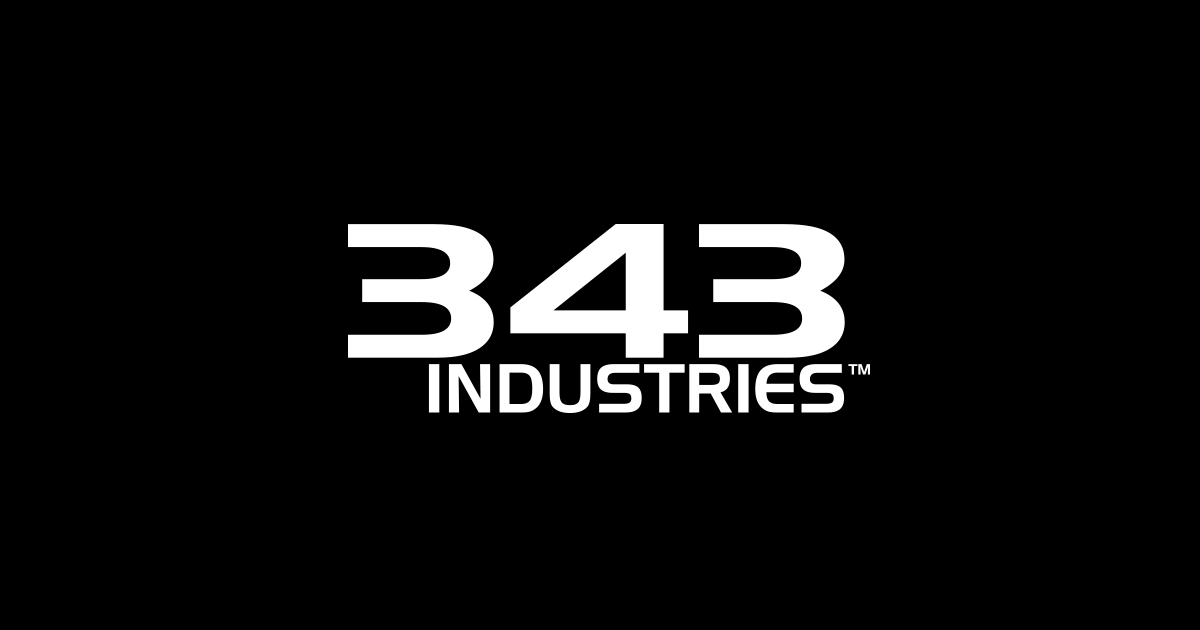Inside Infinite – October 2021
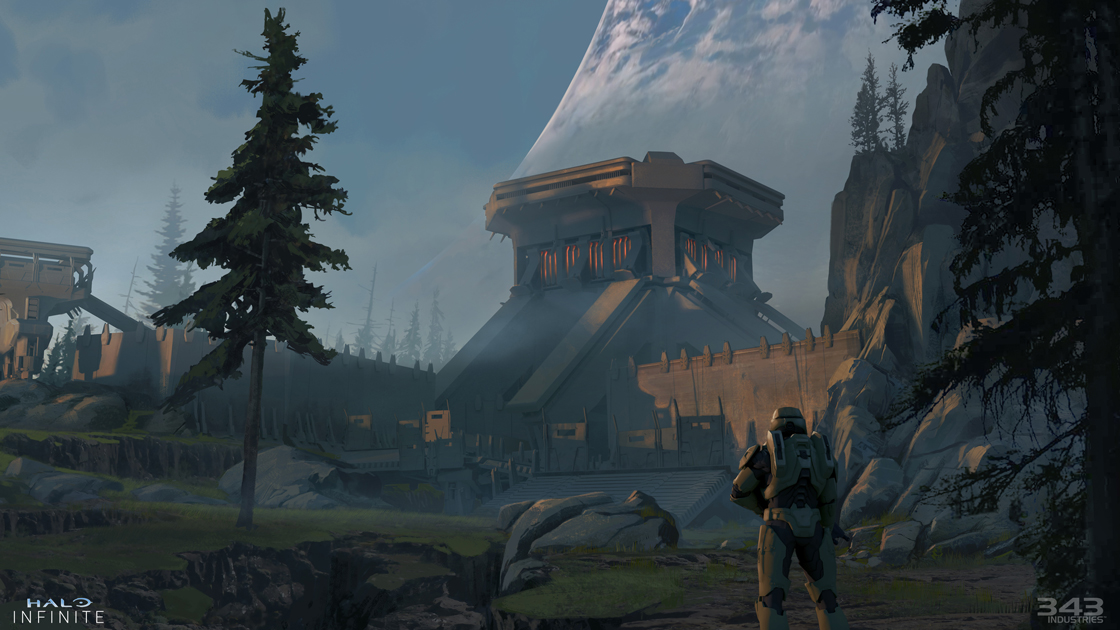
Welcome to our latest installment of Inside Infinite – our monthly blog series devoted to celebrating some of the tremendous work happening to bring Halo Infinite to life. So much has happened since we kicked this off back in December and we’re so grateful to have you with us on this journey. We’ve covered a lot of ground together over the past 9 months digging into Halo Infinite’s development and getting to know some of the talented people across the team. We’re super eager to be in the final stretch now, with our December 8 launch quickly approaching, but there are still stories to be told.
This month we’re excited to welcome members of the UXUI and Character Teams to share insights about their work on Halo Infinite. But, before we jump into that, if you haven’t yet seen the recently released Campaign Overview video, you should stop what you’re doing and give it a watch!
If this is your first time joining us, be sure to check out our past blogs to learn even more about the work going into our most ambitious Halo game yet:
For even more Halo Infinite goodness, be sure to check out our recent PC Overview or if Competitive Multiplayer is more your speed, don’t miss the Competitive Settings/Gameplay Reveal!
To kick things off, we’re joined by several folks on the Halo Infinite Character Team to talk about their approach and process to create some of the familiar and brand-new characters seen in the Campaign Overview video. Then, we’ll switch things up and hear from members of the UXUI Team to learn about their broad range of work and contributions to the game. Lastly, to wrap things up, we’ll get another quick rundown of Tales from the Trenches and welcome back Joseph Staten, Head of Creative, for some closing thoughts.
This month we really are pushing the limits of “how much blog is too much blog?” so, get comfy - we’ve got another heaping dose of behind-the-scenes info and beautiful visuals in store, so without further ado, let’s talk characters!
CHARACTER STUDY
Whether it’s our favorite super soldier, a menacing cloaked Elite, supportive Marines, or wise-cracking Grunts, the characters of Halo connect us to the stories, adventures, and gameplay we’ve come to know and love for nearly 20 years. This month we sat down with a few members of the Character Team at 343 Industries to learn more about their work, their approach, and how they are bringing familiar and brand-new characters to life in Halo Infinite’s expansive Campaign. Please note: the high-res renders below are the source models captured in-engine using our development tools and don't necssarily represent exactly how they'll appear when encountered in-game.
Hello, Character Team friends! Please introduce yourselves and tell us what your role is at 343 Industries and what you’re responsible for on Halo Infinite.
Steve (SD): Hi there, I’m Steve Dyck and I’m the Character & Combat Director on Halo Infinite. I’m responsible for design direction and creative direction for AI combatants. This involves the way they look, the way they behave, how tough they are, etc. This is all part of the work my team and I are responsible for.
Bryan (BR): Halo there, my name is Bryan Repka, and I am the Character Art Lead for Infinite’s Campaign. My team is responsible for the character visuals that show up in Infinite’s Campaign. This includes AI Combatants like Grunts, Jackals, Hunters and Brutes, as well as the many Narrative characters that make up the game.
JuanCarlos (JC): My name is JuanCarlos Larrea and I’m the animation lead on the Character team. We are responsible for gameplay animations for all non-playable characters.
Nick (NA): Hey I’m Nick Avallone, Senior Animator on the Character team. I like long walks on the beach and mangling Banished bodies with keyframes and math.
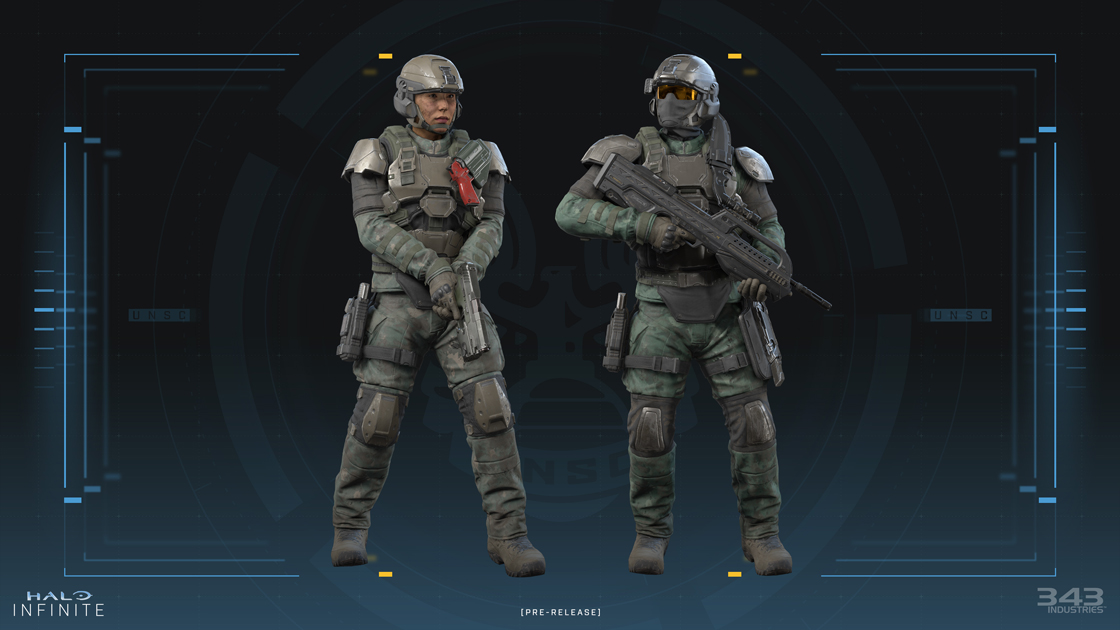
A render of UNSC Marines, which will join Master Chief as he battles across Zeta Halo. (Or, drives off a cliff.) [For the above image in full res, click here.]
We’ve spoken with a variety of teams across Halo Infinite and they’ve each shared some version of pillars or goals that help inform and inspire the work they do. What does that entail for the Character Team?
SD: These are the high level goals the Character / Combat team keeps in mind while making decisions on AI combatants and measuring if we feel we have been successful in our delivery.
Create compelling AI Combatants:
This is addressed by both aesthetic and gameplay. We want clear reasons around the role of our Ai and why a designer would choose to use a Grunt vs a Brute, Jackal or Elite. Each one of these characters should bring a unique experience to combat. This differentiation is most important when we look at our base level enemies, for example a Brute vs. an Elite vs a Grunt vs. a Jackal and so on. Within each one of those base characters, we also create variants that support different roles and gameplay challenges. Another thing we talked about early in production was “embracing the sci-fi”. What is meant by this is with Halo being a sci-fi franchise, we have an opportunity to try different things with different Alien species that a lot of other shooters do not.
Player Comprehension
This is also addressed by both aesthetic and gameplay. We strive for the player to understand who they are engaging in battle with and why one target may be more important to take out than others. We do this with a combination of art, animation, design choices, and behaviors.
In addition to this, player feedback is an especially important factor when addressing this goal. Whether it be the scale of a hit reaction, FX feedback, or what an AI says, it should all contextually make sense to the player and help them understand if what they are doing is effective or whether they need to change tactics.

Render of a Banished "Spartan Killer", a formidable foe ready to face off against Master Chief. [For the above image in full res, click here.]
With nearly 20 years of history to pull from, how did the team strike a balance between staying true to legacy character designs while also ensuring they ‘fit’ within the visual and design language of Halo Infinite? How does the game’s overall approach to “Spiritual Reboot” apply to characters?
SD: The spiritual reboot actually made it easier for us to incorporate some more legacy designs into the characters. One of the best examples of this are the Elites, Grunts and Jackal who all have a much more “legacy” design to them than we had in Halo 4 or 5. In terms of which part of the legacy we looked to for inspiration, we settled most around the Halo 3 / Halo: Reach timeframe and then incorporated the Banished aesthetic where it made sense along with the Halo Infinite art direction.
BR: From an art standpoint, we knew early on that we wanted to spiritually reboot our characters and that meant taking a look at ALL of our characters. Every character in Infinite was redesigned in some way. Like Steve mentioned, we really relied on the designs of the past. We wanted to get back to the legacy designs that made Halo characters iconic, but we didn’t just want to just up-res them. We wanted to add our own flair while staying true to the 20 years of history. I will use the Elites as an example – in Halo 4 and Halo 5 the Elites were big and bulky. We ended up scaling them down a bit and giving them more of a sleek look. We wanted them to be fast, agile, and intelligent. We knew this would also be a great contrast to the big hulking Brutes. I couldn’t be happier with how the Elites look and perform in Infinite.
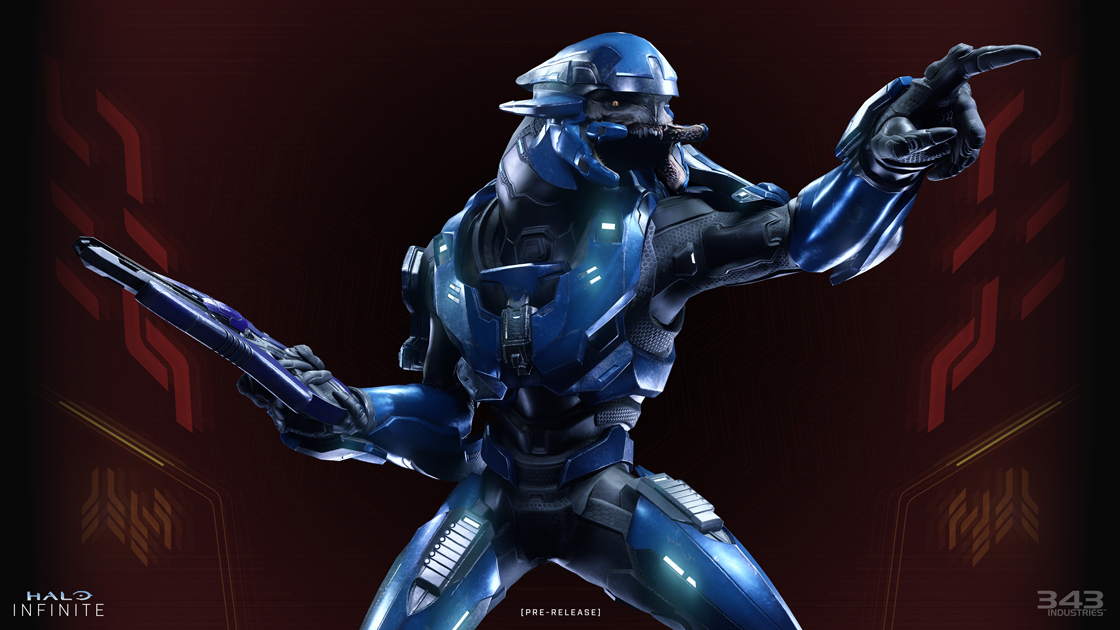
A render of an Elite - looking better than ever, still agile and deadly. [For the above image in full res, click here.]
The return of Brutes, and the Banished in particular, surely presented new challenges and opportunities – how did the team approach bringing these enemies to life in Halo Infinite?
SD: The return of the Brutes was a challenge the team was very excited to pursue as they are a great adversary in the Halo Universe. We wanted the Brutes to feel very aggressive but not like “dumb space monkeys.” We talked a lot about the desire for Brutes to feel more visceral as well. The player will experience this in everything from the way they attack, how their armor can be shot off, and the VO (voice-over) they use. Brutes as an enemy are a nice juxtaposition from a character like the Elite that tends to be more composed and tactical. The Brutes are all about “Brute force” for lack of a better way of putting it, and this shows through in the gameplay. For example, where an Elite might peel off from combat and take cover, a Brute will be more likely to charge the player in a rage.
BR: Ah yes… The Brutes!! Who doesn’t love them some Banished Brutes! The team rose to the challenge with these bad boys. There was a ton of legacy here that we wanted to stay true to but also find ways to push the boundaries.
One of our main focuses, from the player's perspective, was to create a sense of visual damage that set the Brutes apart from the other enemies. As you fight the Brutes you will see all kinds of armor and debris flying off them from shoulder pad to thigh pads to helmets shooting across the map. Knowing this, we knew we had to design the armors in such a way that facilitated this. We designed the Brute techsuit with various attachment points so that we could modularize the armor plates so that they could be shot off. Funny enough, early on one of the challenges that we had with this approach was in certain cases, by the time you finished off a Brute he would be pretty much naked and bare. This is why they flaunt a full body techsuit. 😊 The team had an absolute blast working on them.
JC: The Brutes have this commanding presence and they don’t all fight the same way. They are extraordinarily strong, carry a lot of weight around, and they have this pent-up anger that needs to come across clearly as they fight you. That gave animators a chance to explore their physicality in different situations and with different weapon types. They can be explosive, and while they are not as agile as Elites, they are just as dangerous. It really is fun to animate them.

Render of a Brute Berserker. Be warned, they are angry and they will charge. [For the above image in full res, click here.]
And speaking of Brutes, we have to ask – how’s Craig doing? Up until this week's Campaign Overview video, it’s been a long time since we’ve seen or heard from him. We see he’s received quite the glow-up since last July. What are some of the key areas the team has been working on since last year’s demo?
SD: Haha, the team has sort of a love-hate relationship with Craig. While it was fun to see the community gravitate towards Craig, he unfortunately represented some content and systems that were not ready for prime time in that demo. The positive outcome of Craig was that he was one of the factors in gaining some more time to finish work and get Brutes to a place where the team is happy with them. This is one of the many positive examples of 343 working with and aligning with the Halo community around expectations. Players who look hard enough will still be able to find some evidence of Craig in Halo Infinite, his spirit lives on!
BR: Craig is in good hands, trust me! He has gone through some changes, but I am here to say that he has glammed up. He is feeling very good about himself and has fit back in well with the rest of his Brute friends. He has also picked up a new hobby and has done well for himself. Long live Craig!
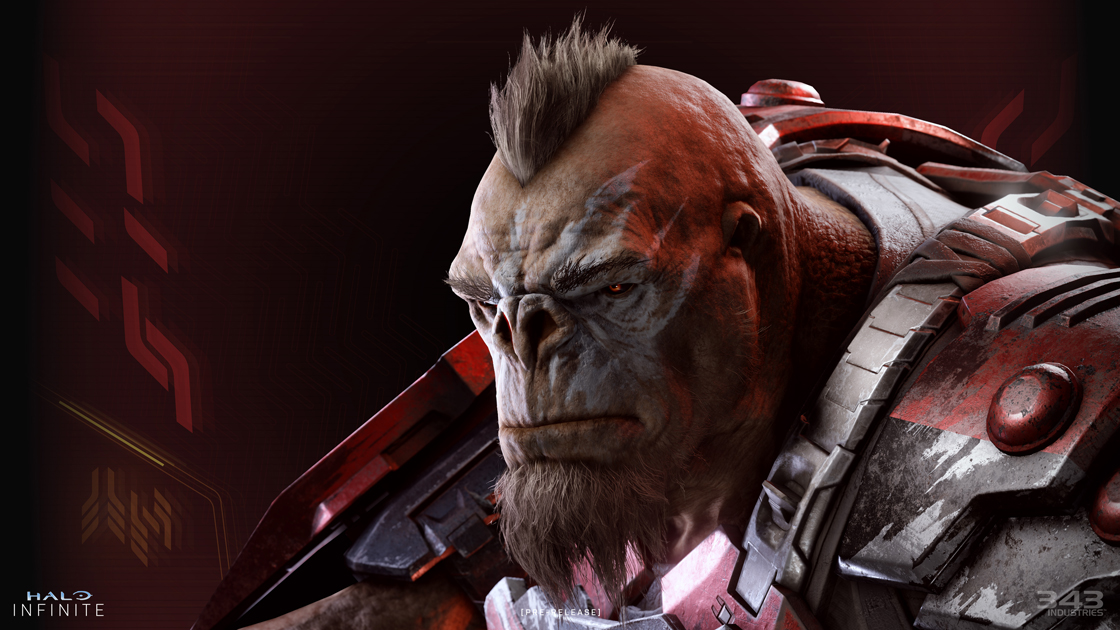
Render of an incredibly detailed Brute. Craig did indeed get quite the glow-up! [For the above image in full res, click here.]
Walk us through the high-level process of how a character goes from idea to living, breathing, entity on Zeta Halo. How does art, animation, design, and audio all come together to deliver a fully realized character? Does gameplay drive character creation or does a cool character concept drive gameplay direction?
SD: We try to drive AI combatant / character creation from a gameplay need as much as possible. We will look for a role that we are missing or is underrepresented and that we think would be interesting to fight from a player perspective. We talk about what will make this character unique from other AI combatants and try to develop what we would often refer to as a character’s “special sauce.” If a new character did not have “special sauce” and was just an analog for an existing character in the game, then there isn’t a lot of justification for making that a “new” character. For example, there aren’t a lot of characters in Halo that put the player back on their heels. The Elite Zealot is a good example, but you don’t see them a lot, which is part of their appeal. So, we look at that and say, are there other characters that can fill a similar role, should we add more? These discussions ultimately lead to things like the Brute Berserker, which fills a gameplay need and is a strong fit for the Brutes’ aggressive personality.
Once we have a role defined, a paper design, we will start working with concept on very loose sketches and start doing rough in game prototypes to help establish silhouette, proportions etc. that in turn inform concept. If a prototype is fun and compelling, we will continue to refine across the board with higher fidelity art, animation, and start adding some audio, FX, etc. If the prototype isn’t fun, then it’s back to step one to discuss where things went off the rails and if we can get them back on track. If we are going to fail, we want to do so as quickly as possible before we start bringing in more disciplines. The most important thing at this stage is it’s ok to have a prototype fail as long as the team is learning and making more informed decisions as we move forward. As we go further through the process, eventually we will get into full production on a character where the team is working on content, design tuning, and code that will be part of a shipping character.
Narrative characters can be a little different where they are driven more from a story need as opposed to a gameplay need. The Pilot is a good example of this where his role fills many narrative needs but is much lighter on the gameplay side of things. With that said, the same amount of diligence and rigor goes into making these narrative characters a reality.
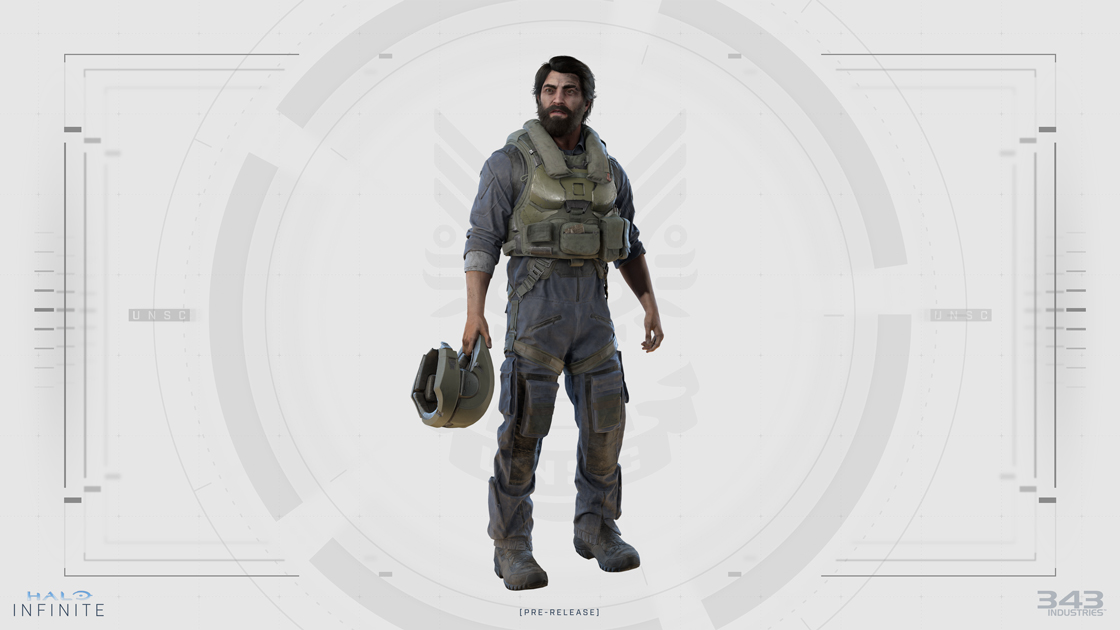
Render of the Pilot, a new narrative character and ally of Master Chief. [For the above image in full res, click here.]
What are some of the key differences between returning characters in Halo Infinite vs. prior Halo titles? Does the evolved sandbox and gameplay in our most expansive Campaign ever have any impact on character design?
SD: There has been a lot rebuilt from the ground up for Halo infinite in terms of AI behavior that absolutely takes the evolved sandbox and more open gameplay into consideration. For example, those new Fusion Coils the player can grab and throw can also be thrown by Brutes….at times a Brute may even toss a Grunt at the player. The other thing we need to support on the character side is the effectiveness of things like the new equipment vs. characters. The evolution of the sandbox has given the player more options in combat. For example, the Grappleshot will pull you to a Brute, be deflected by a Hunter, and not attach to a Jackal but will pop their shield to the side so the player can get damage onto the body. Another evolution that may surprise players is some of our smarter AI will upgrade their weapon, when possible, by grabbing a better weapon off a rack, the ground, or even a Grunt Mule.
The more open nature of the combat also meant our engineering team had to do a lot of work on behaviors and systems to account for the 360 degrees of combat so the player still feels like Master Chief and can wade into combat without feeling overwhelmed. With the bigger more open combat spaces we wanted to maintain that Halo feel which means allowing the player to be aggressive and remain on the offensive, as opposed to feeling like they are playing a cover shooter.
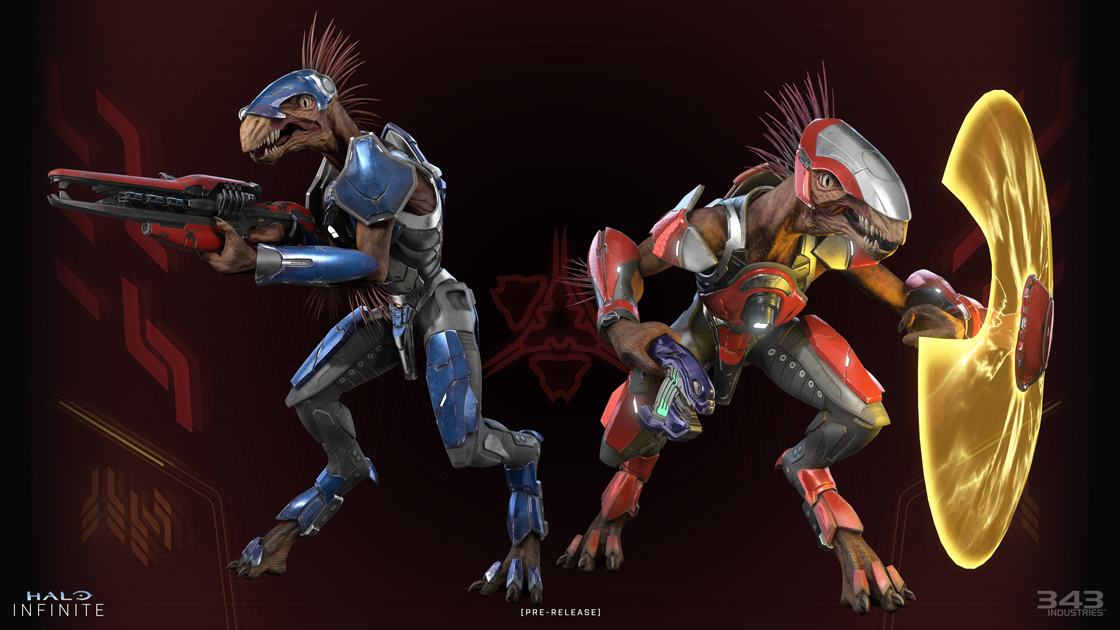
Render of two different Jackals. Shield or not, these wily enemies are no push-overs. [For the above image in full res, click here.]
Historically we’ve seen the same species have different roles in combat, which is usually denoted by different armor styles, color of armor, or weapons. Why, from a gameplay standpoint, do members of the same species wear different armors and colors throughout the game?
SD: This is a great part of Halo’s legacy and I think is equally as impactful now as it was 20 years ago. The use of vibrant color to help the player identify threats or variations of enemies is a key part of Halo. I can still remember in Halo: CE when I first saw a Gold Elite and was like “Who’s that!?” This is a legacy we are continuing with Halo Infinite as it is great for player feedback and Halo as a game. From a gameplay standpoint, in a shooter at times your target can be small on screen, and it might be hard to know if your enemy is carrying a Plasma Pistol or a Stalker Rifle. This is where color and silhouette can be informative to the player in terms of target prioritization and support gameplay at the same time as supporting a rich visual set of enemies that is iconic to Halo.
Fictionally we look at the different armors as being in line with function as well aesthetic distinction of rank on the battlefield. While we go further than say modern military uniforms, it is a distinction of rank within the enemy faction.
BR: From an art side of things, our job is to compliment gameplay and I think the team did a great job pulling it all together! With color and silhouette playing a huge factor in player readability we wanted to really lean into it. To achieve this, we built all of our characters in a modular fashion so that we could mix and match and create large amounts of variants per species. For example, the player will notice multiple armor variants within the Brute minor role - Brute minors with very little armor and Brute minors with a lot of armor, small shoulder pads and large shoulder pads. As far as the color progression goes, like Steve mentioned, it is foundational to Halo and Infinite is no exception to that. Along with the modular swaps you will see multiple colors within the Brute minor rank helping to denote the strength and weapon that that character wields.
With the Banished playing such a huge part in this game, as well as sticking to a legacy pillar, we knew we didn’t want every character to be outfit in the “Banished” red and silver. We still wanted to have yellow Grunts and blue Elites running around Zeta Halo. We struck a balance by keeping those legacy color schemes while sprinkling in some Banished armor sets here and there! A good example of this would be the Grunt Mule. The Brutes outfit this Grunt in a Banished armor set and made them carry their power weapons for them. It just makes sense :)

Render of a Grunt Mule - the Banished equivalent of a Postmates weapon delivery service. [For the above image in full res, click here.]
We’ve already gotten glimpses of some new, super awesome characters, called “Spartan Killers” – how did these come to be? Where did the team draw inspiration for these new designs?
SD: From the start of Infinite one of the things we wanted to pursue were more “Boss” or “Mini-Boss” type characters. This evolved into conversations around how these could manifest themselves in the game. The Spartan Killers were an early theme around an elite force of Banished that could go toe-to-toe with a Spartan, and win! From there we started talking about who they would be, what species, and what they could do that would set them apart from their factional counterparts in both gameplay and aesthetic. As funny as it might sound, we talked about the A-Team (TV show from the 80’s) when it came to the red and black color theme of the Spartan Killers, we just didn’t give them the sweet van to ride around in. :)
BR: When the design brief for the Spartan Killers came to us, it was hard to contain the excitement. A group of an elite Banished force that was head hunting Spartans? Uh yes please! We wanted to find a way to set this group apart from the rest of the enemies but at the same time make sure that we have cohesion within the group itself. We went with the black armor theme with splashes of red blades. Each Spartan killer is unique and has its own story and battle trophies. That’s all I will say about that!
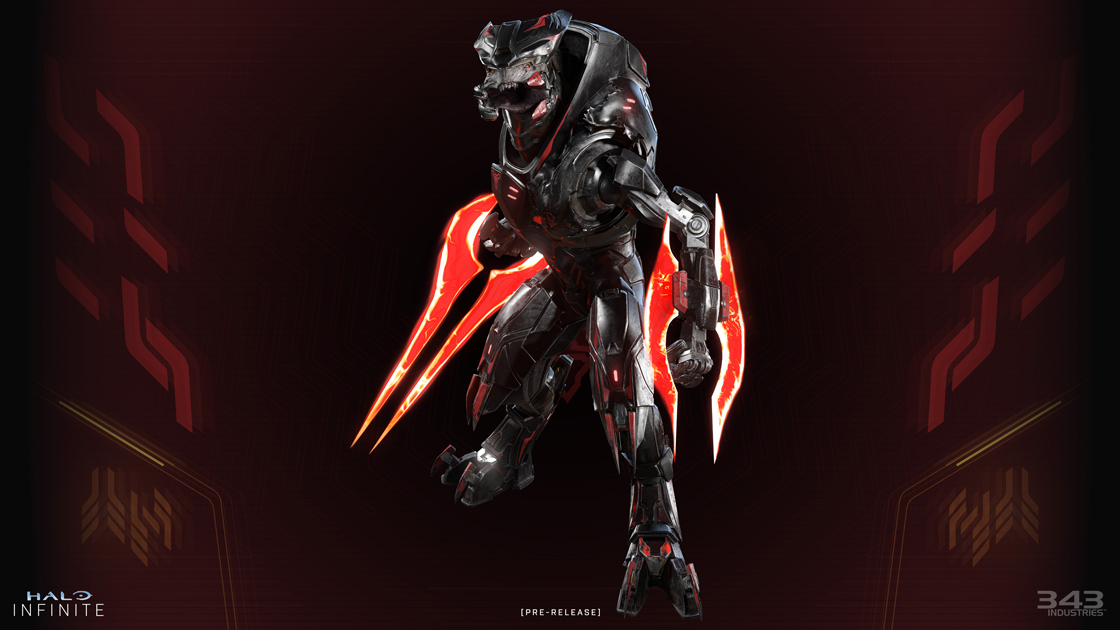
Render of another menacing "Spartan Killer", Jega 'Rdomnai. Shout out to our fellow Jega stans! [For the above image in full res, click here.]
We know you likely can’t provide too many specifics, but are there new species you can encounter in Halo Infinite?
SD: Yes, there are new species as well as new variants and combat challenges that are unique to Halo Infinite! One of the new enemies we just revealed in the Campaign Overview is the Skimmer. While I won’t give away everything about them, what I can say is they are a mid-tier combatant, sort of on the level with the Jackals and higher tier Grunts. They aren’t full flying enemies but have hover packs to allow them to move around quickly and provide unique challenges and opportunities to the player while on foot or in a vehicle. We didn’t want to pursue a full flying enemy as we found in an FPS flying enemies can get a little frustrating and disorienting as the player is forced to look up. Skimmers, like their namesake, move around by just skimming above the ground. We can’t talk too many other specifics before release, but we are just beginning to scratch the surface of the mysteries this ring holds and that includes enemies. We can’t wait for fans to get their hands on the game and discover the new goodies.
NA: Like Steve was saying, the engine treats these guys like ground combatants, so the character animation team was tasked with making them believably “hover” above the ground. We have a few techniques for doing this, like changing their height and jetpack orientation based on how fast they want to move and rotating their bodies as they slow down to simulate “braking.” A lot of work went into the unique way they interact with vehicles, and I’m really excited about how that turned out. (Keep your tanks clear.) When they’re emoting and taking damage, we found the biggest challenge was balancing where their weight was supported at any given time. It was definitely one of the more difficult characters I’ve had to shoot reference for and have since blasted all of that footage into a decaying solar orbit.
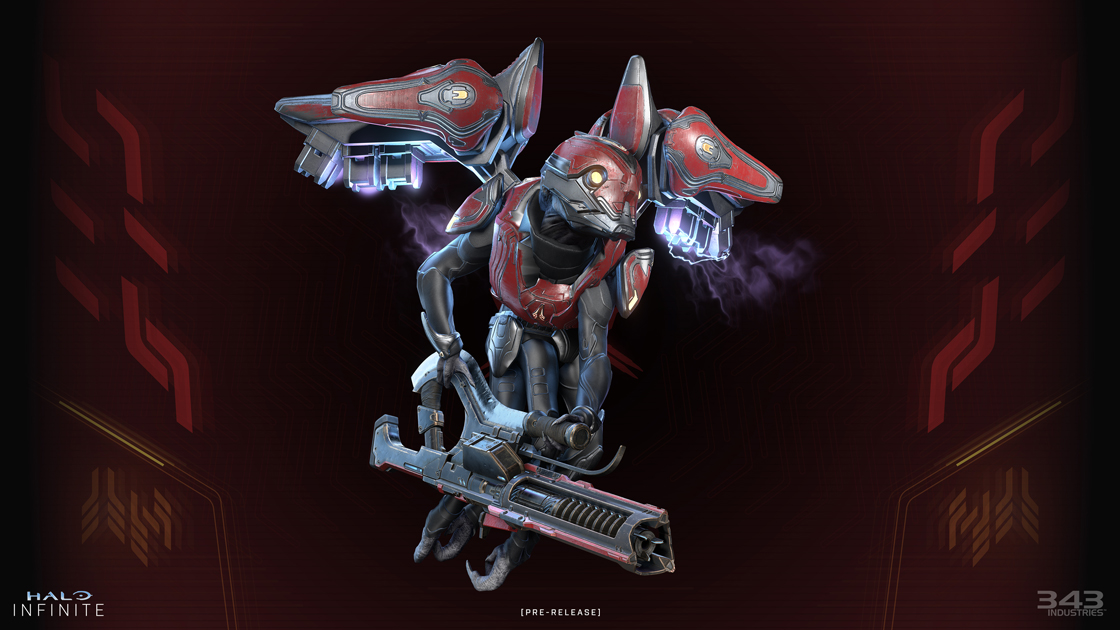
Render of a new species you'll encounter on Zeta Halo - the Skimmer. [For the above image in full res, click here.]
Ok guys, thank you so much for sharing some Character Team insights with us today! Before we let you go - what’s your personal favorite character in Halo Infinite and why? (No Spoilers!)
SD: Without giving spoilers I’d say the Brute Captain (Officer) is my favorite without spoiling any new additions. His usage of the Jetpack leads to tons of unique and fun combat situations. Aesthetically he also looks badass and has fire shooting out of his back. It’s super satisfying to blow up their jetpack and take them out! I know you asked for just one, but I have to give a special shoutout to the Grunt Mule. Think Treasure Goblin but in Halo. This variant of Grunt scours the battlefield picking up weapons and grenades and has them attached to their back for either the Banished to use or the player to use. Grunt Mules can be a great way to get power weapons in Infinite!
BR The Grunts for me have always been a favorite and being able to work on them was a surreal experience. They have always been such a comedic character in the Halo universe, and we held nothing back in Infinite. Just camp around some Grunts and you can listen to their VO for days. You won’t be disappointed!
JC: I have to go with Grunts too. They have personality and they are a great vehicle for levity. Their awkward proportion and weight distribution gives animators a lot of room to try things that you wouldn’t try with any other character.
NA: I think it’s the Jackal. They force you to use more finesse and patience than usual, but in the end their gameplay loop feels really rewarding to me. I also get a lot of joy out of their maniacal, broken language taunts and weird chicken-like death throes.

Render of two different Grunts. What they lack in intimidation, they more than make up for in wit. [For the above image in full res, click here.]
Thank you Steve, Bryan, JuanCarlos, and Nick for the insights and the awesome high-res renders showcasing some of the team’s fantastic work in Halo Infinite! Next up – we’re talking user experiences, user interfaces, and checking out some great design with members of the UXUI team.
UXUI FYI
The “UXUI” (“User Experience” and “User Interface”) Team at 343 Industries spans a variety of critical, and sometimes nuanced, facets of the Halo Infinite game experience that all work together to drive immersion, accessibility, and fun while unifying it all in the Halo Universe. From the HUD we experience in first-person to how we engage with our Spartan customization to fictional detailing on our weapons and a breadth of accessibility features – the hard-working folks on this team are, in many ways, the glue that binds the entirety of the experience together. This month we’re joined by several members of the UXUI team for a deep dive into their vision, approach, and a closer look at some of the key work that’s been done in Halo Infinite.
Hello! Please introduce yourselves and tell us what your role is at 343 Industries / what you’re responsible for on Halo Infinite.
Vincent: I’m Vincent Hui, the UX Design Lead on Halo Infinite. My job is to enable all the awesome people I work with to make amazing experiences for everyone to enjoy. I also dive deep into every piece of feedback the community delivers to make sure that all our players – new, legacy, fans, pros, console, PC, content creators, viewers, etc. - are satisfied with their Halo experience.
Chad: Hello! I’m Chad Mirshak, UI Art Lead on Halo Infinite. My role covers a broad spectrum of visual direction - driving the high-level 2D/3D presentation of our UI to collaborating with other art teams on in-world design and storytelling elements to aligning our design language across ecosystem-level marketing and transmedia efforts. We are joined at the hip with UX and partner with all the various feature teams across the studio to ensure a consistent, polished presentation for our players.
Paige: I’m Paige Johnson, I’ve been leading both Production for UX/UI and Accessibility on Halo Infinite. My role is wrangling our schedule and deadlines, while making sure we deliver at quality. I also build and maintain our processes and relationships with all our partner teams in the studio. For Accessibility, I strive to learn as much as can about best practices and champion them at the studio, as well as work with User Research and the Gaming and Disability Community.
Eric: Hey there! I’m Eric Dies, Realization Lead working on Halo Infinite. My role leans heavily on conceptual development to help make grounded, artistic choices within our 2D & 3D menus. I’m a designer who leverages aspects of storytelling, visual design, animation, and more to create experiences and systems with a particular mood and tone. I’ve been working with tons of talented, multi-disciplinary folks to bring our Customization & Battle Pass features to life as well as various aspects of our UI’s visual design, motion, and design system(s).
Omer: Halo! My name is Omer Younas and I’m a Senior Visual Designer on Halo Infinite. I joined 343 just over a year ago; designing UI across Campaign, frontend through to HUD, as well as in-world branding (like our iconic weapons), motion design and iconography. My daily duties require a huge amount of collaboration across UX, Design, Engineers (+ many other disciplines) to establish cohesive visual design whilst also ensuring our quality bar is consistently achieved throughout the player experience.
Roxy: Hey I’m Roxy Garza, a Senior Creative Technologist on Halo Infinite. My role is to bring UI features to life by designing and building UI and coordinating with production and the other teams that support the backend. I have been focused on the frontend menus and specifically the Customization area of the game.
Casey: Hi, I am Casey Donelson (He/Him), Senior Technical UX Designer on Halo Infinite. I am the primary designer for the HUD and many in-game UI elements for both Campaign and Multiplayer.
Ian: My name is Ian Saterdalen. I’ve been coordinating and helping the UX/UI team deliver designs, UI art, and code from a production capacity. As we move into a live service, I have been leading the team to help establish best practices to help us be sustainable and deliver awesome experiences for many years in the future!
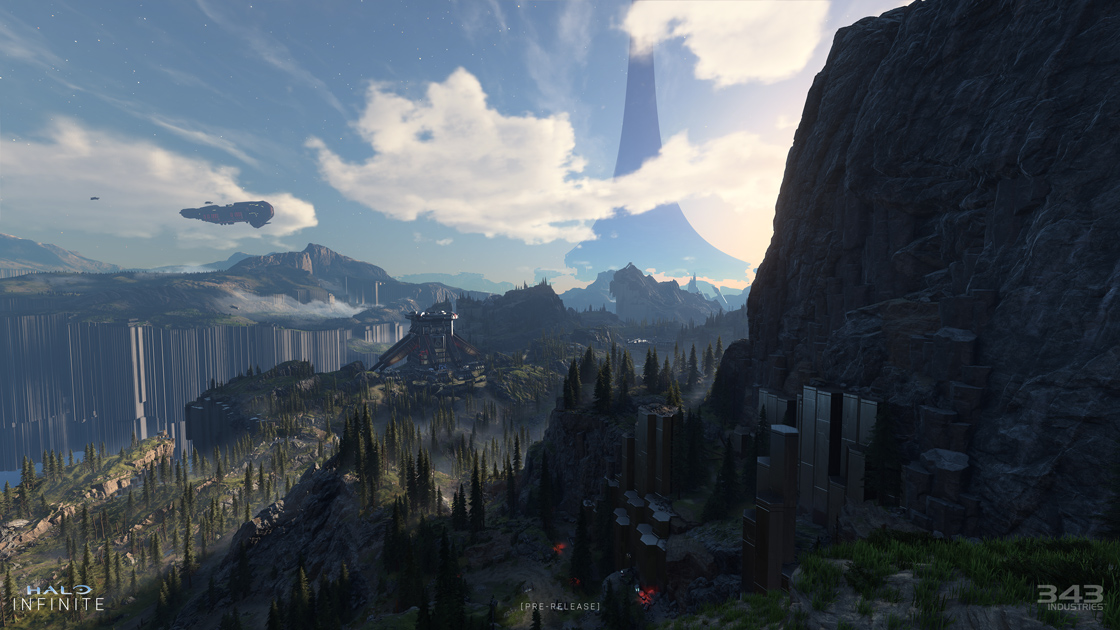
Central pillars, you say? A view of Zeta Halo as shown in the Halo Infinite Campaign Overview. [For the above image in full res, click here.]
The UXUI team is involved in many aspects of the game – do you have any high-level central design pillars that help guide and inform the work you do?
Vincent: Our charter is: To empower our users with inviting, engaging, and intelligible interactions. This means that it must do more than just work – it must look and feel premium and be easy to use and comprehend. Our community has lofty expectations, and we strive to meet and exceed them.
Chad: Modern Legacy is a simple yet apt term that we leverage as a guiding principle throughout our graphic design journey. We want to ensure that Halo Infinite has a distinct, contemporary visual signature that captures the lighter, more uplifting spirit of “hope” (one of the game’s core creative pillars) that allows it to stand on its own among the library of Halo experiences yet remain reverent to the legacy direction that has now become iconic after 20 years(!).From an overall presentation perspective, an overall experience design goal was to help navigate the player through the larger world of Halo Infinite - a minimalist UI layout that bowed to the realization of location, content, and gameplay. Ambient storytelling and world-building was at the root of this direction – finding moments to elaborate upon the rich environments and lore that has been created for the game, bring our player’s Spartans - and the world they inhabit - to life, and give the player opportunity to explore spaces they may not have been able to during traditional gameplay.
The UXUI team is responsible for many iconic elements that really define a Halo game. Can you talk about some of the challenges you faced when evolving some of our legacy UI? What goals and reasons informed the changes we see in Infinite vs. what we’ve seen in past Halo games?
Vincent: One of the major goals we had was for the UI to get out of the way of the strong visual experiences we were delivering in environments compared to past Halos. The front-end menus are a little more muted to let the Spartans and scenery shine.
For the HUD, we removed the helmet geometry and shifted persistent elements out of the top corners – like grenades and weapons - to reduce eye fatigue, cognitive load, and Arena sweatiness, which were serious issues called out by Halo 5 players. These things were caused by the layout forcing players to scan all four corners of the screen constantly during gameplay. We want the pressure that players feel to come from the gameplay situation and not from the HUD layout.
By moving these elements to create breathing room, players can also enjoy the skybox and the Halo ring, find vertical targets faster, and have a better experience when using the Grappleshot.
Chad: The ground rule we laid out early in the process (and a previous question!) was “innovate and modernize where we should, but don’t change for the sake of change.” There are so many ingredients that make up the recipe of a classic Halo experience, and each legacy element that we approached to iterate on demanded the utmost care to preserve the essence of that legacy. There are a couple of spots where players will notice some changes (like the weapon cradle Vince mentions above) but I would say the biggest departure was our front-end menu designs, where we shifted away from the classic darker tone and Halo blues and embraced a flat, more minimalist approach that acted as a complement to in-game 3D presentation, rather than full-screen 2D UI experiences.
Eric: Like many aspects of the project, preserving what’s sacred to our legacy while also pushing the franchise forward is a constant back and forth that requires meticulous testing and player feedback. The team has collectively been pursuing such and really cares about the community’s opinions here. The pursuit of “modernized legacy,” from my perspective, has been a lot like walking a tight rope strapped over a hungry Gravemind. It’s a constant balancing act. Go too far one way or the other and well… you get the idea.
Omer: The HUD has always been a signature of the franchise with the many of the legacy call backs using blue wires to frame the radar, weapon cradle and shields. We minimized the visual clutter on screen to really allow players to focus on the gameplay while evolving and modernizing the visual language of the elements on screen. Contrast and quick readability drove many of the design choices to allow critical info to be conveyed through motion and clean messaging. Use of gradients soften the harsh look of flat, linework as well as allowing the players eyes to be guided across the screen along these leading lines. These design choices enhance the flow of information and presentation whilst retaining that signature look. Take any gameplay screenshot, from any part of the game and you will instantly recognize it as Halo Infinite.
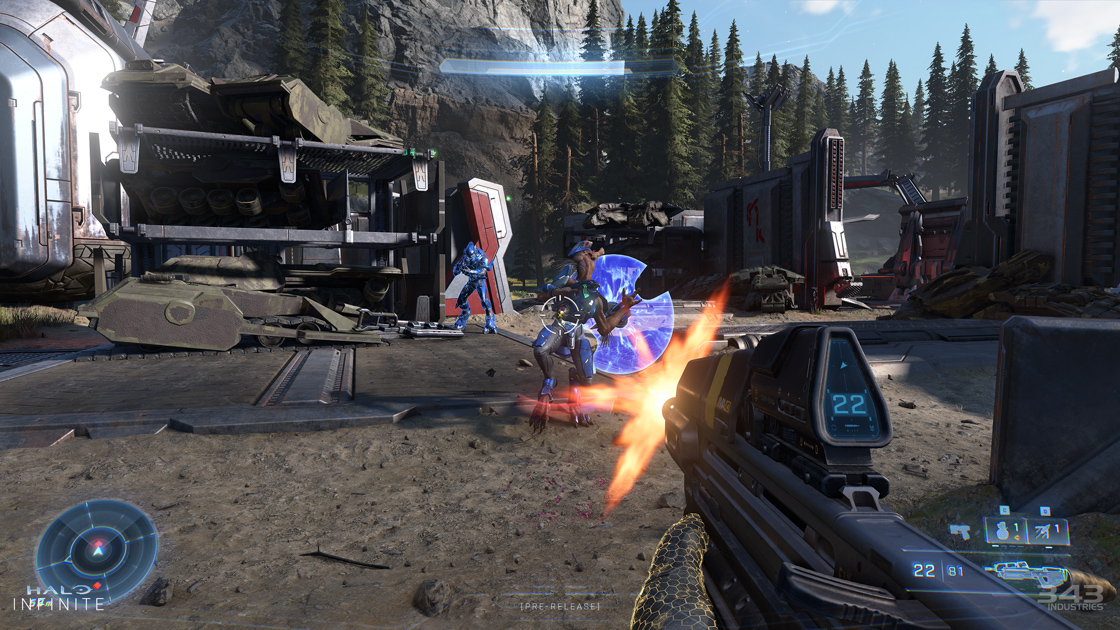
A Halo Infinite Campaign screenshot depicting the first-person HUD during a battle against the Banished. [For the above image in full res, click here.]
Are there additional specific HUD considerations between Campaign and Multiplayer?
Casey: Absolutely. We have some non-player facing considerations, like making systems functional between both Campaign and Multiplayer. Each team has unique needs, and often we need to create a solution that works for both.
Overall, Campaign has a stronger narrative need, so a lot of the information in the HUD is used to help elevate the story, while still providing the player with the information they need to understand the current state of the game. There are moments where we know we can do unique things with the HUD because the player will be in a non-confrontational part of the game.
Multiplayer has a heavier focus on having “at-a-glance" information. There is a balance you must strike between providing information and gaining attention. If you do too much of either, the HUD becomes obtrusive. Multiplayer also has more specific user types that need to be accounted for with the HUD. From casual to competitive, Slayer to BTB, everyone is going to have a unique need or desire for how they want the HUD to function. Sometimes, we need to make a decision that is acceptable for most use cases but may not be the best solution for some specific situations. We are always taking feedback and adjusting where we can. Further, we are looking into ways we can provide players with even more options to adjust the HUD to their liking in the future.
Chad: As Casey mentioned, our Campaign HUD is chock full of bespoke elements that make perfect sense for the sake of our story but don't have immediate application for Multiplayer - these include everything from mission trackers to holographic terminal interfaces, suit firmware upgrades, a fully realized 3D map, archives, even assassination dossiers (is your interest piqued yet?). On the Multiplayer side, our HUD has evolved in some ways but many of the classics are there: personal feed, medal displays, kill feed, and the various scoreboards that are catered to each game mode. Even though there are many unique elements in each respective gameplay experience, we ensure that there is a visual consistency across both so that the player can jump between Campaign and Multiplayer and it be an intuitive experience. We are planning to bring some player-customizable elements into our HUD, so stay tuned!
Eric: Casey & Chad have really done a great job covering on the differences in philosophy between Campaign & MP. Each have their own bespoke needs as the nuance of each experience shift in terms of gameplay.
These types of considerations also extend into our Campaign Cutscenes as the intent of our UI elements shift from informing users about gameplay mechanics towards the microscopic details of the narrative itself. In a variety of our cinematics, there are moments where the details taking place within the UI are just as important as our characters’ actions on screen. To support such, we’ve gone through great lengths to build out in-engine VFX-like UI elements that serve as carriers of various messages to our players. These grounded UI elements serve to flesh out the realization of our narrative moments while also providing essential context (and even subtext) to specific scenes.

A GIF showing how storytelling extends into the player's VISR OS.
Internally, the team built out a consistent design language that’s been referred to as “VISR OS.” Can you explain what this means and the work the team has done to help unify some of the game UI even further?
Chad: VISR OS originally started out at a very small scale: Neptali (our Fantasy User Interface designer) and I sat down to concept out a new AR ammo display, with the goal of finding an approach that nudges it towards a more modern design aesthetic but remains reverent to the classic presentation that everyone knows and loves. We aligned with Art Direction and Sandbox on a language that felt like the right balance of old and new: a minimalist design that feels utilitarian and clean, while being extensible enough for us to preserve much of the original feel across a variety of display needs. Soon after the AR we started to work on the Commando rifle, then the BR, and Hydra, followed by the Warthog dashboard... and design patterns starting to emerge. While the concept of VISR has long existed in Halo lore it had never formally been given a full realization pass, so we got to work to establish VISR OS as a grounded, in-world aesthetic, eventually evolving it past simple display elements and into a full-on interaction language that the player can navigate as an extension of Chief's primary visor display – both Eric and Omer jumped on board and did a great job of adapting and evolving that language into something that our players could use across a variety of channels.

Examples of the unified "VISR OS" seen through Halo Infinite. [For the above image in full res, click here.]
Eric: The language of VISR has been in our lore for quite some time, but when considering the various portions of the UI that might make the cut as a candidate for elaboration, it was one of our first picks.
As Chad was saying, we’ve extended VISR both in terms of its visual language as well as its application. Historically it has quietly fueled the abundance of tactical messaging to our users within MJOLNIR armor systems. That remains the case both in terms of function and intent, but as we’ve elaborated on our gameplay and mechanics, we’ve extended its application as well. Weapons new and old, entirely new menu systems (some of which Omer will be covering here soon), and a plethora of new user scenarios inspired our approach to further unify the various systems into a more consistent and contextual design language.
Pictured below you’ll find a few examples of how we’ve leveraged the expanded VISR language to not only deliver messaging to our users within the HUD, but also to establish and delineate front-end from back-end systems. Think of our cooler colors visualizing the equivalent of our “Windows” operating system whereas the more neon green elements help to portray the equivalent of our “DOS” back-end. This should help establish a clear hierarchy that will aid our users in identifying immediately relevant tactical information from more grounded, realization that expands upon the fiction of specific gameplay moments.
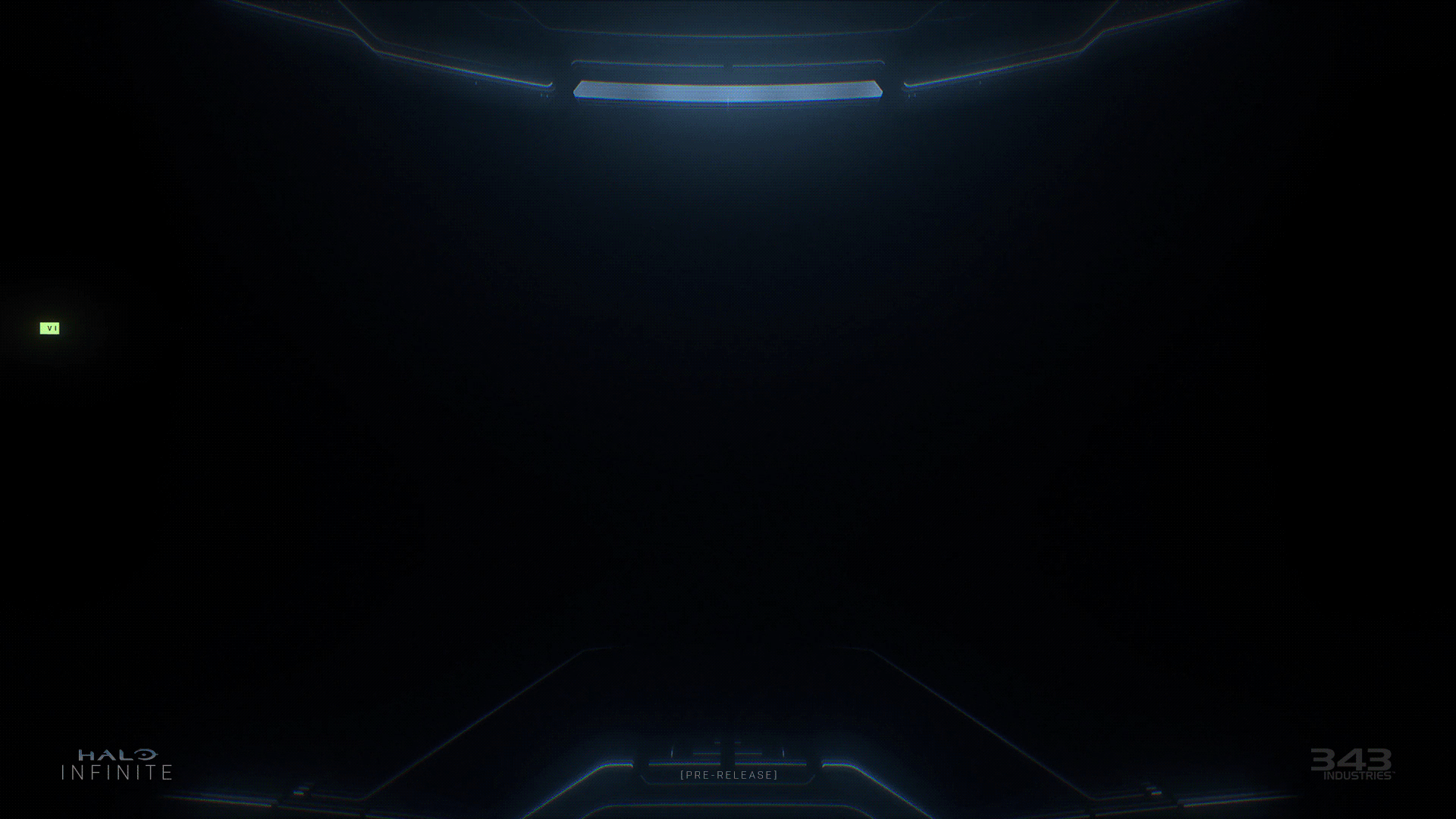
Animated GIF example of the MJOLNIR Suit Upgrade in VISR OS.
Omer: When I joined the project in September 2020 (time flies!), I remember seeing the early portions of VISR OS. (Neptali did a stellar job!) The application of minimal, modern, utilitarian-look was extremely versatile: weaving a cohesive thread across all our UNSC ‘OS' that felt tangible in the Halo Infinite universe. Those early concepts were the inspiration for me to begin creating a player-facing, design system. I began breaking down the FUI concepts and creating a library of components that could be translated into affordances, buttons, tabs, sliders, etc., with a focus on narrative presentation. What elements could we extract / expand on for our VISR OS experience? How would the Master Chief interact with the OS as an extension of his HUD? How do we create an intuitive, robust hub to capture all campaign progression? I was mindful of these questions as I iterated on numerous concepts of the ‘Campaign Gameplay’ menu (internally referred to as the ‘Back-Button’ or ‘BB’ menu). Fans may remember the TACMAP from E3 2020 Campaign Trailer having 3 tabs. With the amount of content in the Campaign we ended up categorizing the content into five main sections:
- TACMAP – An expansive map and mission tracker for players to explore and plan their approach.
- UPGRADES – Master Chief’s equipment and suit upgrades.
- FOB – The available support items from ‘Forward Operating Bases.’
- TARGETS – A dossier of ‘High Value Targets’ to take down.
- DATABASE – A compendium of narrative logs and collectibles found across the world of Zeta Halo.
We wanted to bring a unique flavor to each tab that captured the narrative intent but felt cohesive to the overall VISR experience. We leveraged a variety of clean layouts that aimed to have a central focus per tab. We built the experience around that using consistent UI patterns throughout. As an example, Chief’s hologram was integral to ‘Upgrades’ experience (and seeing how badass you look!). The node-grid was our approach to creating a type of MJOLNIR BIOS, where ‘installing’ cores would upgrade each equipment’s ‘firmware,’ increasing the equipment in power. After exploring numerous layouts, framing and node shapes, we settled on the current version; the ‘node-grid’ and Chief’s holo to its right. As players navigate the grid, the camera will dynamically pan and zoom around the Chief to each piece of equipment, immersing the user in the content (can be seen in action ~4:12 mark in the ‘2021 Campaign Overview’) We really wanted to ground the experience of Chief’s display as this data hub seen through the lens of the VISR OS. This approach was employed throughout each section - keeping the user experience central to the narrative visual design.

Screenshot of Master Chief's armor upgrade menu from Halo Infinite. [For the above image in full res, click here.]
What was the TACMAP design process like? Was an overhead map something the team identified as a need from the start? What are some of the challenges the team faced when trying to bring this to life for our most expansive campaign to date?
Chad: I’d say this was hands-down the most ambitious feature that we supported for Campaign and was one of the more fun (and challenging!) UI features for me personally. Among those challenges, I’d say the biggest was striking the right balance of information vs. presentation – this was a feature that was designed from the ground up to feel like an extension of Chief’s visor HUD, which meant that it needed to serve the player’s needs as a navigation and mission tool but also have a grounded, in-world realization that narratively made sense. Having this be an integrated experience of both 2D and 3D elements meant that we needed to maintain a delicate harmony between those respective layers, but also factor in readability and accessibility – making a slight lighting or effects adjustment to improve part of the terrain (or its surroundings) could have a catastrophic effect on all how readable our UI components would be. Keeping the map (and its larger Campaign Menu interface) a performant experience that could quickly be called up by the player was a factor in every decision made. Overall, I’d say iconography was probably the most iterated upon ingredient within our map experience – not only is it critical to convey mission type, status, and availability but we also need to be mindful to communicate the right amount of information as the player zooms in and out to avoid too much clutter. I’d also like to add a great big shoutout to our partners on the SkyBox Labs team for bringing all this to life!
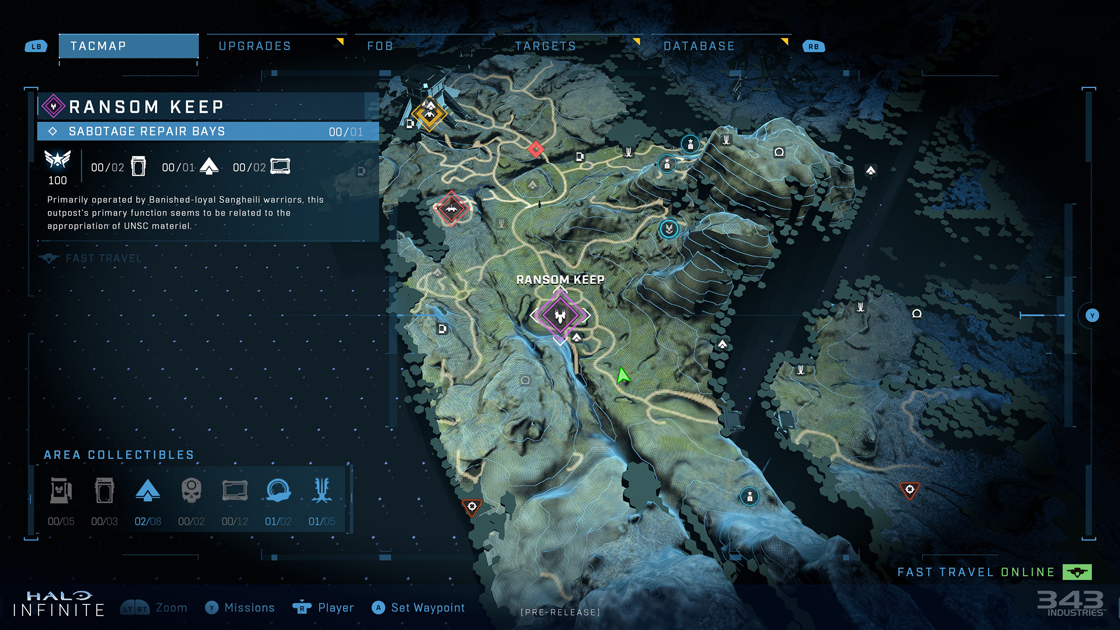
Screenshot of the TACMAP from the Halo Infinite Campaign. [For the above image in full res, click here.]
Omer: The fans finally get to see it in action in the 2021 Campaign Overview! We spent a lot of time and care developing the TACMAP due to it being closely tied to the core of Campaign’s gameplay loop. We worked closely with our external partner team SkyBox Labs to bring this to fruition. Its look was adapted to the rules we had established for the VISR OS. A careful balancing act between many moving parts; multi-state mission icons against terrain, roads, hex-walls and lighting to name a few. Mission Info panel, Mission list and collectibles all had to display over the map, with clear readability… my mind exploded the first time I grasped the full extent of the content we needed to show. Iteration was key to building out the content in a way that was comprehensive and structured. To top it all off we needed this to be quickly accessible making the transition from gameplay to map as quick and smooth as possible, since Halo typically does not have a mini-map on the HUD. We want to allow players to quickly orient themselves or plan out their next move, mitigating any frustrations with slow or clunky access. Looking forward to hearing how players feel about the TACMAP – not long now!
Vince: Campaign’s ambition for a large play space early on in Halo Infinite’s development meant we knew we needed to deliver top-down map to help players go where they wanted to go. The major challenge for any overhead map design is to settle on the level of detail to reveal to the player. Do we let players zoom all the way in and see structures and enemies? Or is the camera pulled all the way back out and only showing icons? Do we show side missions? Do we show places the players have been to? Do we label places? Do cardinal directions even exist on a Halo ring?
Shifting gears over to Customization - that is quite an ambitious feature in terms of presentation. Can you tell us about the philosophy behind how the feature was crafted and how UX, UI, and Live collaborated to bring it all together?
Roxy: The Customization experience was a herculean effort between all the team disciplines. Early on, I worked with Live to understand the underlying Customization system that they built and then wireframed the UI. I wrote specs to define what data was needed for display on the screens, proposed functionality, and consulted with the Live and Services teams to make sure they could support the data we were asking for on the backend. Once that was approved, I built the UI in the engine with our proprietary UI screen editor. From there, the client engineers on the Live team populated the screens with the real engine data in C++. UI Art collaborated with UX to understand the design and create the visual presentation. UI Art would present beautiful ideas and organize the information on-screen, which would result in me iterating on the content in the UI screen editor. I also had help from other members of the UX team on polishing and bug-fixing this massive feature. We had technical artists and character artists working on the individual customization pieces, and environment and lighting artists working on the 3D level. We really wanted to let the 3D model and in-world space shine in the Customization experience. It’s crazy to look back on old prototype screenshots during development and see how far we’ve come.
We talked a lot about “preserving player choice,” in terms of making sure that we could show the customization item, with the Coating that the player already had equipped. So, if you chose to equip a purple Coating, and started browsing Helmets, you’d see all your Helmet choices with that purple Coating on. This meant using a real 3D render of the object, instead of baked-out screenshots for every permutation possible. That was a challenging piece of tech that we worked on with the Live and Graphics team engineers.
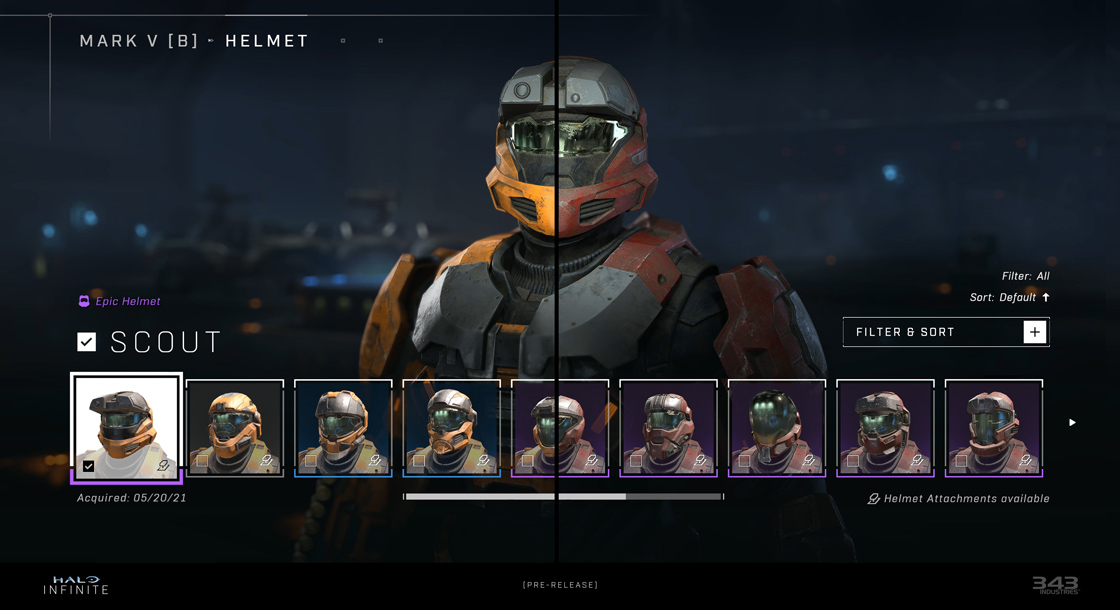
Customation screenshot showcasing that when a player swaps their coating, the 3D Spartan and all item times update to embrace personal choice. [For the above image in full res, click here.]
From the UX side, one of my tent poles of the design was to tell the players “how to get this item” if they didn’t own it. We didn’t want to hide locked items either… we wanted the player to be able to see the items they are missing and find out how they could unlock them. We implemented what we called “deep linking,” where, if the player doesn’t own the item, we communicate: “Available in this Battle Pass at Level X” and provide a link so the player can view the item in that Battle Pass to make decisions. Of course, we didn’t get to ship every feature we wanted, but we added some great functionality that Halo 5 was missing like filters and sorting, along with a cool compare function. You can also inspect and favorite the armor other players are wearing, then filter to favorites in your own inventory later to find the things you liked. We are excited to add more features in the future, and re-think the UI as our selection of content grows.
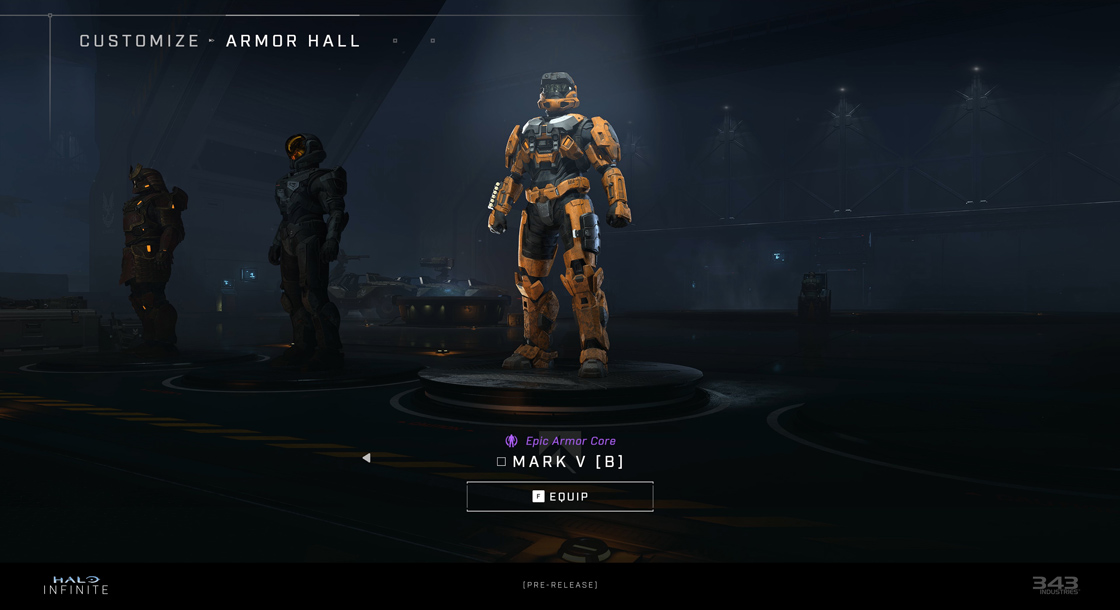
The Armor Hall in Halo Infinite is where your personal Spartan customization begins. [For the above image in full res, click here.]
Eric: Realizing Customization was likely one of the most difficult undertakings of my career at 343. The opportunity to blend concepts of player experience, system design, visual design, and presentation into a singular feature that would empower our players to live out their Spartan fantasy has become one of the most rewarding but challenging endeavors to date. That said, it’s been amazing to witness the partnerships and rallying of teams across the entirety of the studio to bring this feature to life.
Customization has become a bit of a love letter to the fans who have always longed for a plausible evolution of the system from Halo: Reach. With time and patience, we hope it might become an experience the community will one day look back on and remember fondly—especially as we continue to evolve its design and realization over the seasons to come.
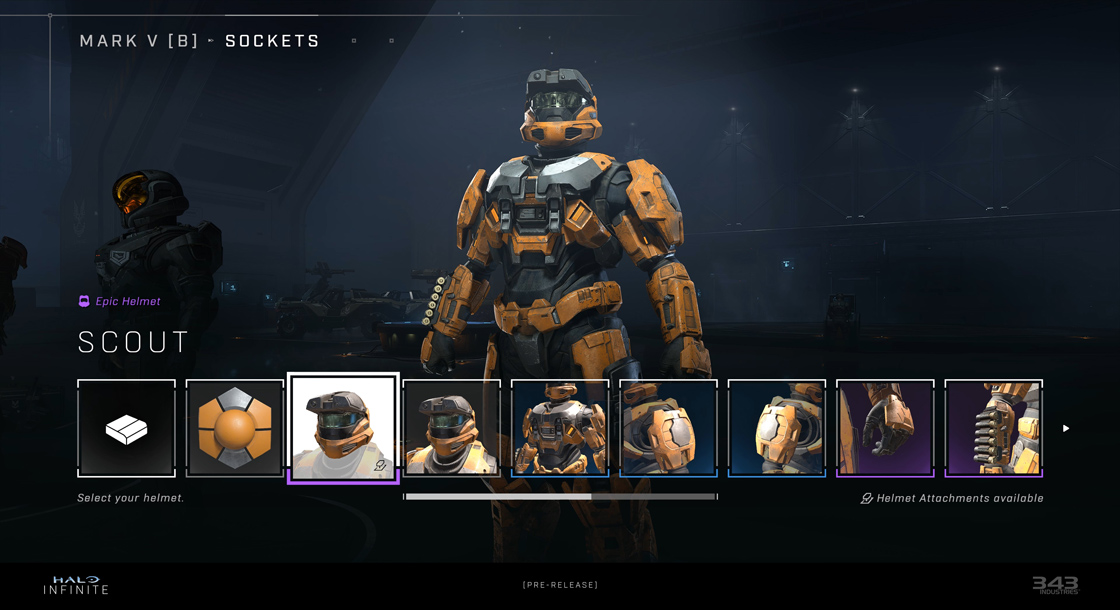
Halo Infinite customization details within the Armor Hall. [For the above image in full res, click here.]
Looking back though, the process of how we got here may be of interest to some. Roughly two years ago, Roxy, Leonard, Chad, and I sat down together to take a hard look at very early progress. It was a labor of love up until that point and nearly all on paper with the exception of the beginnings of systems Leonard and Roxy had stood up. From those early conversations we quickly learned of the various constraints and opportunities we might have in carving out a system that put Chris Blohm & Team’s Live content on display while also digging deep to allow for the feature’s presentation to capture the spirit and tone of the franchise’s long-standing Spartan dream.
Then COVID hit.
We had only met for a handful of brainstorm sessions before the pandemic decided to throw a massive wedge into our studio’s day to day—not to mention change the lives of many worldwide. I don’t want to compare our resulting workflow hurdles with the trauma many have faced throughout these past two years, but at times, the team had to overcome countless communication and resulting tech hurdles as the studio was literally siloed at home. Fast forward to present, things run so much more smoothly. We’ve worked a lot of those kinks out and have built process that accounts for the ever-changing needs of the working-world, but it’s so refreshing to look back and see how we grew. Now, if we’d let the record scratch for just a second (hurray for non-linear story telling), let’s go back and recap some of that beginning concept work and process.
I had first begun by creating very high-level frames or comps. These are very similar to concept art but for our UI & Realization. After circulating a bit and gaining alignment with Art Direction, we moved forward with system and presentation design. For those who are familiar with 3D software, I specifically leveraged Cinema4D as a toolset to build out an animatic of a Camera System I had only built out in paper up until that point. This animatic encapsulated the various ideas of mine and the group’s but filtered and focused into a short vision piece for how the feature might feel if ever realized.

An animated GIF showing early protoytpes and the finished result for the Halo Infinite Armor Hall and customization UI.
It wasn’t long before we then began ramping up our already very busy external partners, Sperasoft and Certain Affinity, to work alongside the various teams at 343 to build, develop, and tune the system in all the manners it required. We created a great deal of net-new and updated tech for this feature as our engine wasn’t originally built to support some of the things we were putting forward, so I know I speak for a great many people in saying we hope you all enjoy the feature.
Now as we approach launch, we have a fully grounded space in our menus to tune and creatively build your very own Spartan(s) armed with an ever-expanding arsenal of weapons, armor, vehicles, and AI. As we continue our final tweaks in this space, know it’s one we’ll be constantly expanding and tweaking over time throughout your seasonal journey. We genuinely have a lot planned and can’t wait to gradually roll those plans out for all of you.
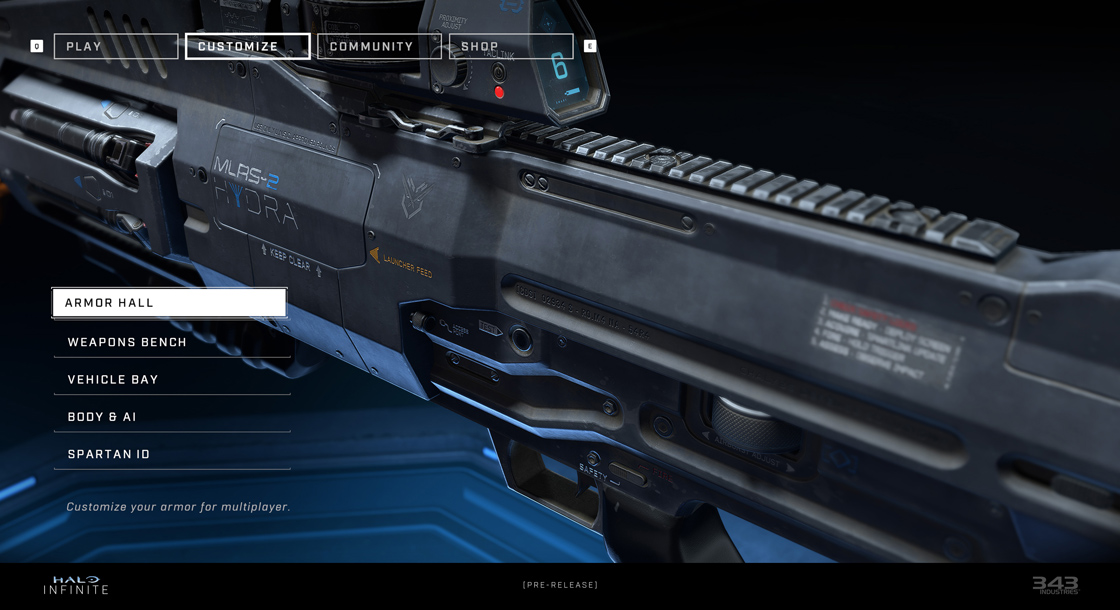
While idle in the Customization menu, an 'attract mode' will cycle through beauty shots of UNSC armaments. [For the above image in full res, click here.]
Chad: Customization is our crown jewel in terms of presentation. The amount of love and effort that has gone into realizing this feature cannot be articulated in written language. When Eric and I kicked off early discussions around how to best realize our player’s customization experience, we landed on two items rather quickly: an environment and tone that evokes the feeling of a Spartan preparing for battle, and camera work that not only communicates hierarchy of navigation but gets in close to celebrate all the small details that our art team has put into our customization options.
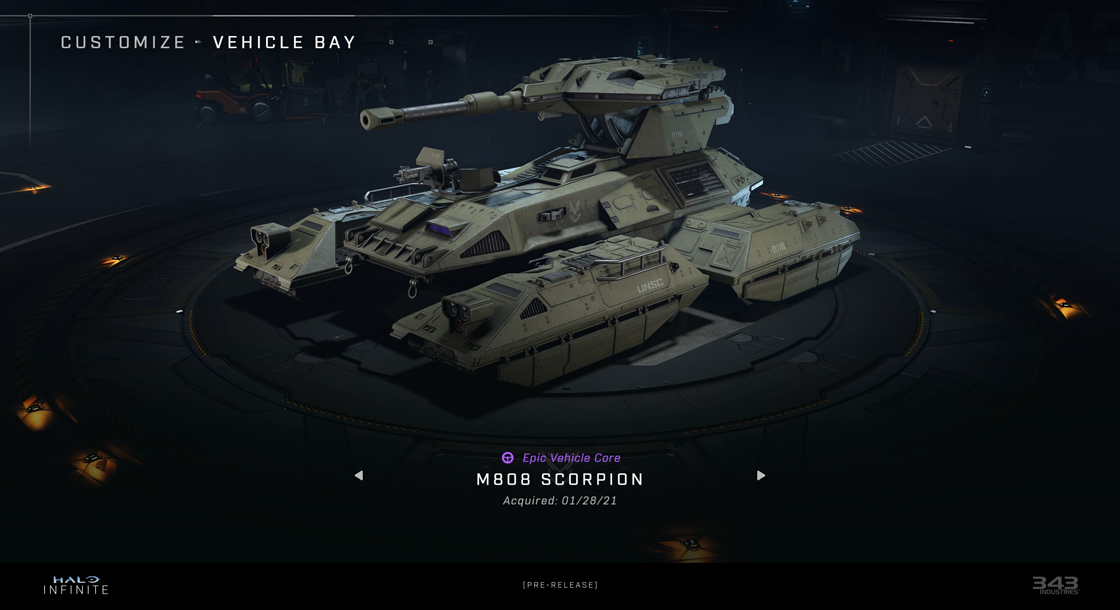
Customization isn't only for armor and weapons - you'll be able to personalize some of your favorite vehicles as well, like the Scorpion above. [For the above image in full res, click here.]
The hangar that we worked with our Environment, Lighting and Animation teams on acted as a perfect ubiquitous space to achieve that and allowed us the flexibility to create specific compositions that best serve the presentation of content while still making each unique category feel like part of a unified, grounded experience. It also opened the opportunity to inject rich background details to bring the space to life – we’ve got marines in the background working terminals, pelicans queued up (my favorite shot that I will never shut up about) and even a few fun callbacks to legacy fan favorites. As we continue to add new features this space will continue to evolve, so keep an eye out for new little details that find their way in as well.
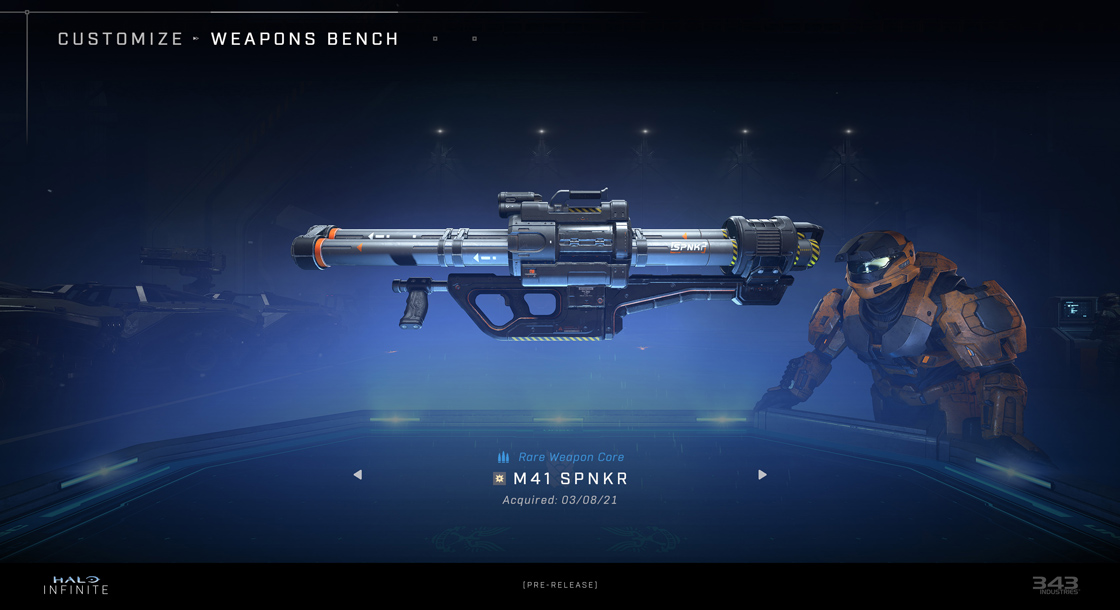
The Weapons Bench, above, offers a closer look at customization elements like coatings and charms. [For the above image in full res, click here.]
A nuanced but very cool project the team also worked on was the creation of manufacturer logos and weapon decals. These little touches and attention to detail go a long way towards further grounding everything in a living, breathing world. How did you approach this design work? How did past reference help inform the refreshed takes we see in Halo Infinite today?
Chad: For me these represent some of the most fun aspects of working on a Halo game: realizing our expansive lore through visual design. Over the course of the project, we've had the opportunity to contribute to many in-world brand elements that would normally fall outside the realm of traditional UI but are essential to effectively grounding the gear that populates the world of Halo Infinite. For our manufacturers we had two workstreams: 1) revisit the classics and "modernize" their design to reflect a more contemporary approach (once again being respectful to legacy), and 2) take our new Infinite-specific manufacturers through a branding process (not too dissimilar to what a marketing agency would do) and create an identity that not only speaks to the brand's values and history but also "feels" at home in the Halo universe. This was a true cross-team collaboration between Halo Infinite UI and Halo Transmedia, and I love the work that our team did here – special shoutouts to CJ, Eddie, Zach, Pat and Neptali - who (for obvious reasons) had to work on our Napthali manufacturer. 😊
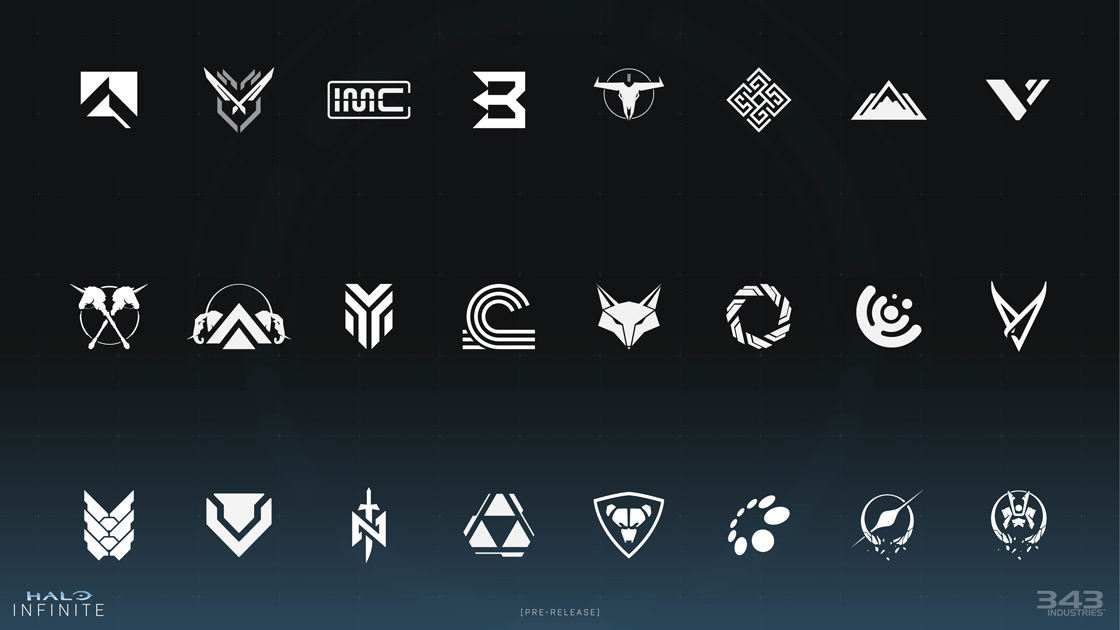
Examples of iconography created for Halo Infinite. [For the above image in full res, click here.]
Eric: Totally agree with Chad’s thoughts here. Pulling our manufacturers forward has been a wild undertaking of various people on the UI & Transmedia teams. For many of us, our backgrounds included stints at a handful of agencies large and small, so it really was a joyful return to much of those familiar workflows and exercises in logo design and branding.
Before going too much further though, I too want to echo shoutouts to CJ Ramos, Eddie Arriesgado, Zach Splan, Patrick Marko, Mo Aoun, and Neptali Cisneros. Without this group of designers, none of this would have been possible.
Diving back in, the historical and cultural reverence of our manufacturers was a sacred aspect of our process when starting to design. Observing not only the brands’ marks but also the original lore that fueled each ranged from either a widely understood reference to a bit understated or unknown beginning, so preserving the known and fleshing out the unknown was a great collaborative process between the collective designers and our Franchise team. Big shoutout to Frank O’ Connor, Corrinne Robinson, Kenneth Peters, and Jeff Easterling who carved out time to collaborate on the research aspect of this project.
Outside of process, the project really was about identifying what was typically considered “deep lore” within the community and bringing it into plain view. There’s a rich history here to pull from, so we really wanted to let players know these aspects of the world, so keep your eyes out for them within our Customization & UI screens.
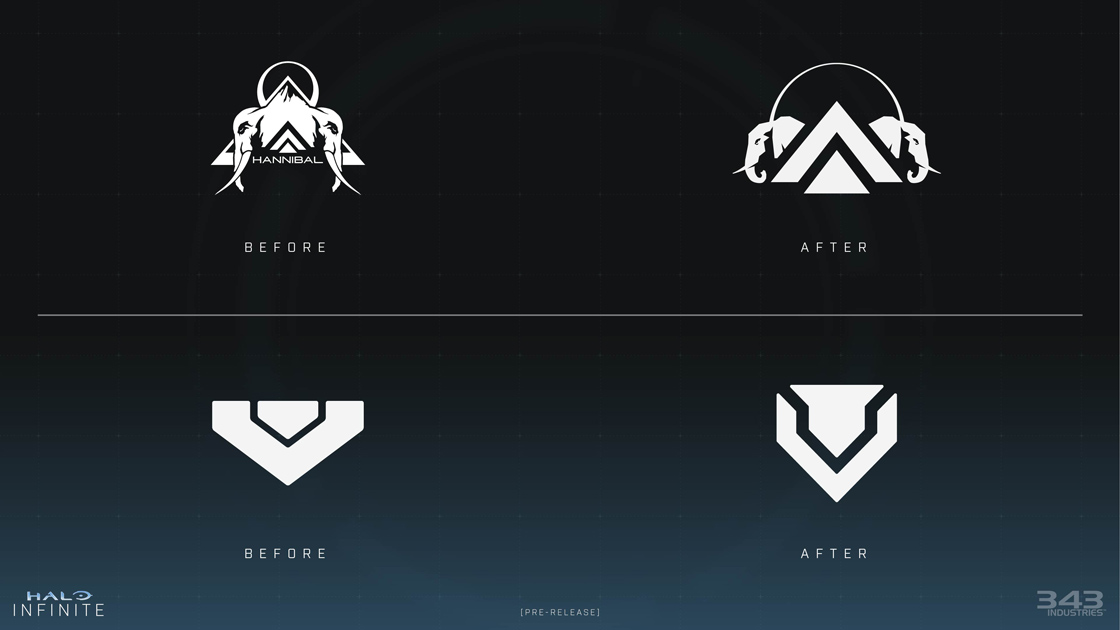
Before and after examples of manufacturer branding updates in Halo Infinite. [For the above image in full res, click here.]
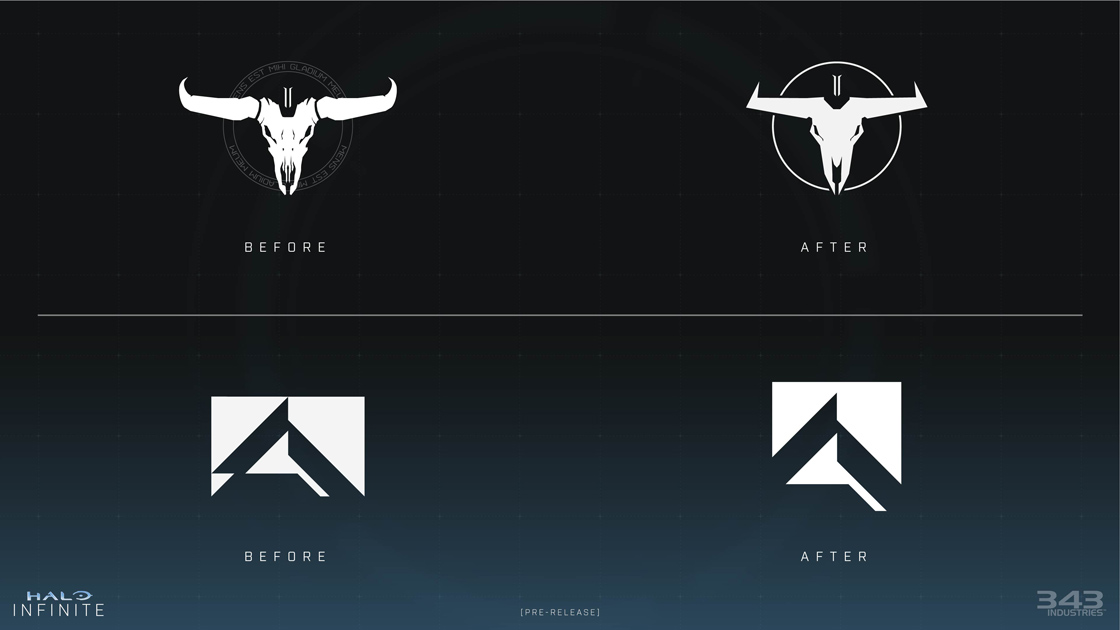
An additional set of before and after examples of manufacturer branding updates in Halo Infinite. [For the above image in full res, click here.]
Chad: On the decal front, our intention here was very straightforward: create a subtle layer of graphic design that not only acts as a realistic grounding for our weapons, but also as an ambient storytelling tool that furthers the lore that our Franchise and Sandbox teams have created around each of Infinite’s weapons. An added layer of note here would be the extent in which we branded each of the weapons – not only are we surfacing utility decal elements you’d expect to see on contemporary firearms, but we went through an extensive branding process that resulted in bespoke logo designs that reflects the personality of each weapon – I really want to get each of these on a t-shirt. (Consumer Products, let’s talk!). Gonna get out of the way of Omer here as this was his baby…

Visual design lends narrative elements and provides a fictional foundation for weapons like the MA40, pictured above. [For the above image in full res, click here.]
Omer: Aww yeah! Chad knows (all-too-well), since joining 343, this has been a huge passion project that continues to drive my hunger for more in-world branding and ambient storytelling. I feel the extent to modernize and deepen the layers of detail grounds everything in a way that transforms game assets into more tangible and believable equipment. I see some fans have picked up on the markings and decals and we really love seeing what you discover – there’s a lot more to come - keep at it! 😊

The Bulldog, above, is all bark and all bite. Consult the user manual before operating. [For the above image in full res, click here.]
To give you a peek behind the curtain, it all begins with a vision to give players the best weapon experience they have ever had in a Halo game. Once a weapon begins production, I rely on the knowledge base of my good friend Kenneth Peters (Senior Franchise Writer). We go over the history and references of every weapon. Discussing all facets from barrel to grip, receiver to stock, magazine to scope, all the way through to electronics. We look at usage in previous Halo entries. This research and preparation helps inform what marking types need to be allocated to each component of the weapon. What is the legacy of the weapon? Was it manufactured in limited supply? Are they multi-planetary? When and where was the weapon built? Where in the timeline does this appear? Is anything retrofitted? These are some of the many questions we ask as we go through development.
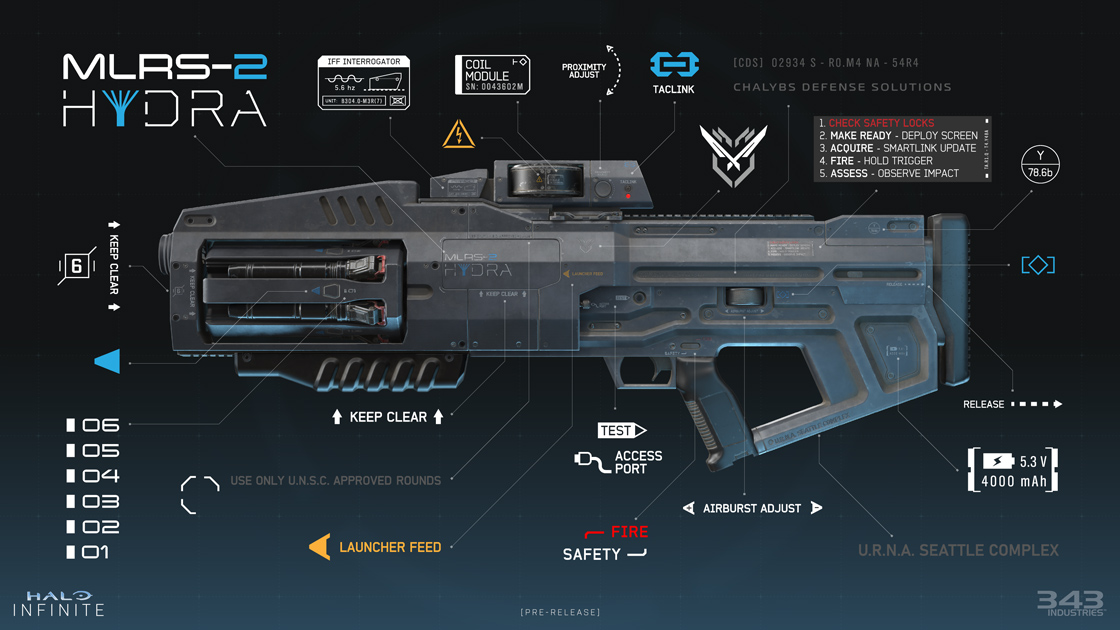
The Hydra, pictured above, can dish out a lot of damage and includes a 5-step instructional decal in case you forget how to operate it. [For the above image in full res, click here.]
The real fun starts with building a foundation of design with the weapon’s primary logo. I liken the thought process to car manufacturers, where each model has its own ‘brand’ and possibly many car brands under a single manufacturer. The logos for our weapons are like those car models – each logo helps to inform the feel / intent of its weapon. This trickles down to the design of the more functional decals and markings with specific fonts, color palettes, shapes, even barcodes / QR codes. Decal placement and scale are tested on all angles of each weapon; side, top, bottom, moving mechanisms and in FPV to get a sense of what players would see during gameplay. As well as checking against reload / idle animations to sneak some smaller details for eagle-eyed players. 😉
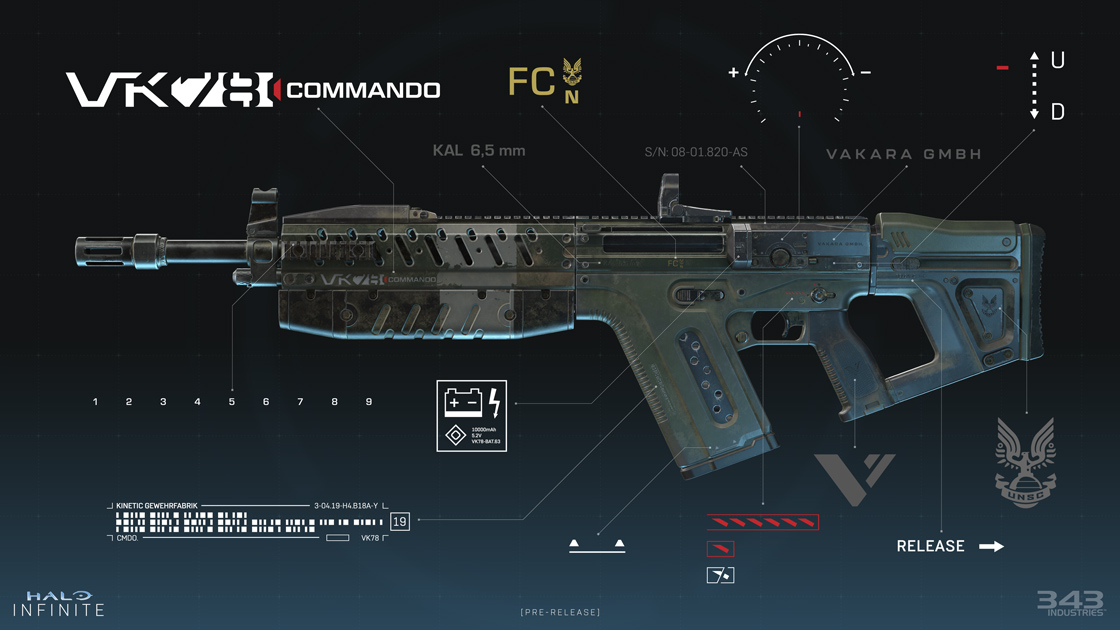
The Commando Rifle, above, is a beast in capable hands - just remember to pace your shots. [For the above image in full res, click here.]
It’s easy to go too far and exaggerate the markings, breaking the confines and feeling too heavy-handed. Anything that can distract from gameplay is up for adjusting or being removed completely. Likewise, too little, and those cool details won’t even go noticed by players. I feel we have struck an exceptionally good balance with these painstakingly crafted markings and decals. I hope fans appreciate the extra effort we’ve gone through to really bring these details to life, evolving the Halo universe in a way that’s respectful to the past and sets us up for a new expansive future - Enjoy!

New weapon manufacturer logos created for Halo Infinite. [For the above image in full res, click here.]
Accessibility is something that is very near and dear to you all on UX/UI. Could you highlight a couple of key features that the team is particularly proud of? Will there be continued work done to improve the product in this respect?
Casey: I am proud of the breadth of options we’ve made available to players. It isn’t always easy to create systems that can be modified from a setting, but we often built them with accessibility in mind from the beginning. That allowed us to create constraints or reject ideas that weren’t going to meet the standards we had in place.
One of the key features that I am particularly proud of is the ability to modify friendly or enemy team colors. I’ve seen a lot of games that force in a color scheme based on a particular color blind setting you chose. This approach felt wrong, as we would be trying to design a feature around something many of us couldn’t experience. Instead, we found it made more sense to allow the player to choose what works for them. After the first Tech Preview, we were all quite surprised at how appreciated this feature was for many players, not just colorblind. Creating systems that have such a significant impact on many players really helps the cause of making accessibility part of the design.
There is always more we can do, and we are actively working on some new features!
Paige: I think how we approached colorblindness is a good example of how we tried to approach accessible design across the game. Make the design accessible, and then add settings for players to adjust where designs may be inaccessible. For color, we worked to incorporate shape language in almost all places that color is used to avoid introducing a need to rely on color alone. Our “nav markers” and team icons are an example of where we used both color and iconography/shape to convey meaning. As Casey points out we knew early on that Friend/Foe relied heavily on color to tell teams apart as well as make them stand out from the environment, at which point Casey and the team started exploring a solution.
“Text Size” is another feature where, even though we had a goal of having all text at a certain size, we knew that it would still introduce a challenge for blind and low vision players. We exposed the ability to scale up text across the entire game, both in menus and the HUD. There was a lot of intentionality and effort from the team in getting this to work. All the way from the engineering work in our font system to the UX and Presentation layouts for the screens to be adaptive. It also introduces a large “testing matrix” to the game, so we’re grateful for the support from our QA team for finding where we needed to iterate. I find myself playing with Extra Large text on my TV in my living room since it strains my eyes less.
The last feature set I want to touch on is “Sensory” settings. As part of focusing on accessible design, the team worked on having several sensory channels of input (visual, auditory, and haptic) for the player for different actions. However, we received feedback from User Research as well as folks throughout the studio that the game could cause motion sickness and other sensory overloads. We worked out a solution to expose settings that players configure for features that can cause motion sickness or discomfort. Creating these was a collaboration across several teams, including PC, Graphics, Sandbox, and UX/UI. We’re open to feedback from the community if there are other settings we should explore for this area.
We’ll be continuing to support Accessibility, both integrated into our core design as well as leaning into player choice by adding new settings. We’re really excited about innovating in this space and continuing to work with the Gaming and Disability Community along the way.
(Editor's note: For more insights into Halo Infinite Accessibility, check out this this feature on Xbox Wire!)
With Halo Infinite we often talk about launch as just the beginning. What should we expect from UI/UX going forward beyond launch? Are there any key areas the team is already exploring and thinking about?
Chad: I don't want to give away too much and ruin the fun, but we've already been hard at work to define a feature roadmap that will see both improvement and evolution to all that we already support in game at launch, along with continual development of new content and features that will roll out over the coming seasons. I will echo the previous point that I want to leverage our UI presentation as not just a tool that guides our players through the experience but also as storytelling device that will allow us to expand upon the vast world that is being created. (Wink wink, nudge nudge.)
Vincent: I read and track all the feedback that the community and our internal team provides so we have a really good list of things the team wants to look at to improve player experiences and the quality of life. Additional settings for player outlines are currently very high on our list since they will give players the opportunity to tune their own gameplay experience, have strong benefits for content creators, and make the game more accessible.
Paige: To be honest, there’s an overwhelming list of things we want to do. There are many factors that go into prioritizing a backlog and defining deliverables for the team to go after. I will say that I cannot over emphasize how important feedback from players is in helping establish that roadmap.
Ian: I’ve worked on many live servicesin my career. There are lots of different areas in the game that we are looking to level up whether it be existing experiences, new experiences, or even better tools to help our team deliver better content. One of the most important parts is for our team to adjust to important critical feedback and bugs that impact players in the live environment.
Thank you for taking the time to share insights about your work! Any final closing thoughts to share with our community today?
Vincent: We have the word “User” in our name, so we work for the community. Your feedback helps us understand where the game can improve and innovate over time. We hope to continue to deliver the improvements to the game you want to see while also adding new things for all players to enjoy.
Chad: Just look forward to you all getting your hands on this and playing the crap out of it! Please keep that feedback coming and we’ll continue to iterate and improve this experience as time goes on – can’t wait to share all the good stuff we’ve been planning.
Eric: Like Vince & Chad mentioned, all of your feedback is pivotal for us making Halo Infinite the best that it can be. We hope these stories of our experiences help humanize the development process a bit as well. We really care about the franchise and your experience with the product, but all of your perspectives are what will continue to shape aspects of the game’s refinement. We can’t wait for you all to get your hands on things though. Find them bugs so we can smash ‘em.
Omer: I can’t wait for the classic fans and new players alike to jump in! We’ve had such a rollercoaster of a year getting this game ready, polished, and almost in the hands of the players. We’ve grown and learnt so much along the way, but it doesn’t stop there – Launch is only the beginning. We want to continue shaping this to be the best Halo experience ever - It’s almost time... Pizza Time!
Casey: Thank you! I love our community. The inspired artwork, designs, cosplay, and even the memes are one of the joys of the community. I often look at reviews and information regarding the HUD of course. There is no blind eye to some of the suggestions or disagreements out there. We have a lot more of this game to create, and we will continue to iterate based on the responses we get.
Ian: It’s been great to see the responses from the fans. Not just the good feedback, but also the constructive feedback that helps us to improve the experiences where players are looking for change. I’m looking forward to going on this journey with all of you. See you on the battlefield, Spartans!
Paige: I am so excited right now to continue to iterate on the UX and UI after our initial launch. The team has already started to brainstorm some amazing ideas and I couldn’t be more thrilled for the direction we are heading, and to include the community’s voice in that.
Roxy: Seeing the positive reception from our flights has been really uplifting and makes me even more excited to improve upon the game after it comes out. I’m so glad that players are having fun with it so far. I love this franchise and how creative all the community members are.
TALES FROM THE TRENCHES
Each month we put out a call across the studio for additional anecdotes and insights from folks deep within the development trenches. It’s been a whirlwind month coming off our last Multiplayer Tech Preview and making final preparations for launch and this time we’ve got some tales from the HCS and Transmedia teams and a story about our very own Superintendent…
“One of the things I do here at 343 is work on a lot of process automation to take annoying, rote work out of the hands of our developers so they can focus on doing the actual work of making Halo Infinite. I’ve written a bot (called the Superintendent) that studio members can talk to via Microsoft Teams. It’ll do things like start a new build of the game on the build farm, let people know when they have a new high priority bug, etc…
Along the way, I’ve been trying to inject a little bit of a sense of wonder and entertainment. One of the things I love about 343 is the quirky sense of humor shared by a lot of my co-workers. When the opportunity came to troll my teammate on the Audio Team, Chase, I couldn’t help myself.”

Josh and Chase have a discussion about Superintendent's latest... witticisms.
- Josh Lindquist, Principal Software Engineering Lead
---------------------------------------------
“Last month we announced and released tickets for the HCS Kickoff Major Raleigh 2021. This has been not only in the works for a very long time, but it was also special, given that the last Halo Esports event was DreamHack Anaheim in February 2020.
We knew that the community was going to be excited about getting back together and playing on LAN, but we didn't think the whole event would sell out in less than a week. As soon as the VIP tickets sold out in just a few minutes and hundreds of general admission tickets sold we thought to ourselves, ‘oh, this is very different than events in the past.’ We then got a call from our partners at Esports Engine and they let us know that historically spectator tickets sell closer to the event and that at this rate this was on track to be something special. They weren't kidding.
The reason I share all of this is because we want the community to know and feel that this is really the mark a new era for Halo and Halo Esports that's being brought forward with Halo Infinite. If you're going to be in Raleigh, we hope you'll say hi to the various 343 members that will be onsite because we ultimately we want to say thank you for the tremendous support.” -Tahir Hasandjekic, Esports Lead
----------------------------------------------
“Working on all our video content for Infinite has been a blast! One day we’re recording BTB footage for a Tech Preview stream, the next we’re interviewing Joseph Staten, helping Esports with the competitive settings reveal video, making press kits, and more recently, the Halo Infinite Campaign Overview video! It was almost done but there were a few pickup shots the team needed to re-capture to finish up, specifically the sequence of shots where Chief is freeing the Marines.
We spent a while blocking out the shots and trying different approaches and angles. Originally, Chief and the Marines were going to drive off around the corner, but for one take, Paul Crocker suggests driving off the cliff! I mean who hasn’t loaded up a Warthog with Marines to go off jumps? When I stitched everything together to make sure it fit the timing and VO, everything lined up perfectly! Watching the reactions to that sequence made my day when the video dropped and the memes that followed were even better! And yes, the Marines, Chief and the Warthog all made it out unscathed.” - Josh Hnosko, Live Broadcast Producer
And finally, to close out this installment of Inside Infinite, we pass the baton to Halo Infinite’s Head of Creative, Joseph Staten, for his top-of-mind thoughts. Take it away, Joseph!

In Halo Infinite, Master Chief has more tactical choices than ever to bring to bear against Banished installations. [For the above in full res, click here.]
SUPER SOLDIER BASE ASSAULT
First, if you haven’t watched the Halo Infinite Campaign Overview video, please do. Especially the “Ransom Keep” sequence that begins at 3 minutes and 34 seconds because that particular part really shows off how the character, UXUI, and many other teams have joined forces to create a part of the Infinite campaign experience that feels classic and innovative at the same time. An experience that we call… “Super Solider Base Assault.”
Sorry, I mean: “SUUUUUPER SOLIDER BAAAAASE ASSAULT!” You gotta lean into the movie trailer announcer voice because decimating fortified alien war-bases truly is epic good fun. And here’s why:
Halo games have always been about freedom, and more specifically: the freedom to make interesting tactical choices to optimize your power projection inside a rich physical simulation. While previous Halo campaigns have been chock-full of interesting choices, none have had a world simulation that comes close to Halo Infinite’s.
Specifically, Banished bases like Ransom Keep aren’t obstacles across a linear path. They don’t have one or two or three avenues of attack; they are approachable from every cardinal direction—and often from above and below as well. They don’t just have designer-crafted, pre-placed weapons and vehicles that encourage you to lean into a particular set of tactics. These mighty fortresses stand ready to repulse any arsenal that you choose to deploy against them.
And that’s actually pretty smart of the Banished. Because Super Soldiers have many, many choices.
These include equipment, and if you look at the sequence of the Campaign Overview video that begins at 4 minutes and 13 seconds, you’ll see a first glimpse of how Halo Infinite gives you more freedom than ever before to create your own personal Spartan combat style.
Do you want to invest in your Threat Sensor to improve your reconnaissance capability before executing a stealthier base assault? Do you prefer to amp up your Shield Core to enable a more tank-like, smash the-gate-and-danger-be-damned approach? Maybe the Grappleshot is your priority to maximize freedom of movement and manipulation of battlefield objects like Fusion Coils? All of these decisions and more are just fine by us.
Because Halo Infinite is a game that always does its best to say “Yes!” to you and the choices you want to make… and that includes the choice to launch a perfectly good Warthog full of newly-liberated Marines “safely” off the side of a mountain.
—Joseph Staten, Head of Creative for Halo Infinite
